Organizational Theory and Research Assignment PDF
VerifiedAdded on 2021/05/30
|32
|9650
|35
AI Summary
Contribute Materials
Your contribution can guide someone’s learning journey. Share your
documents today.
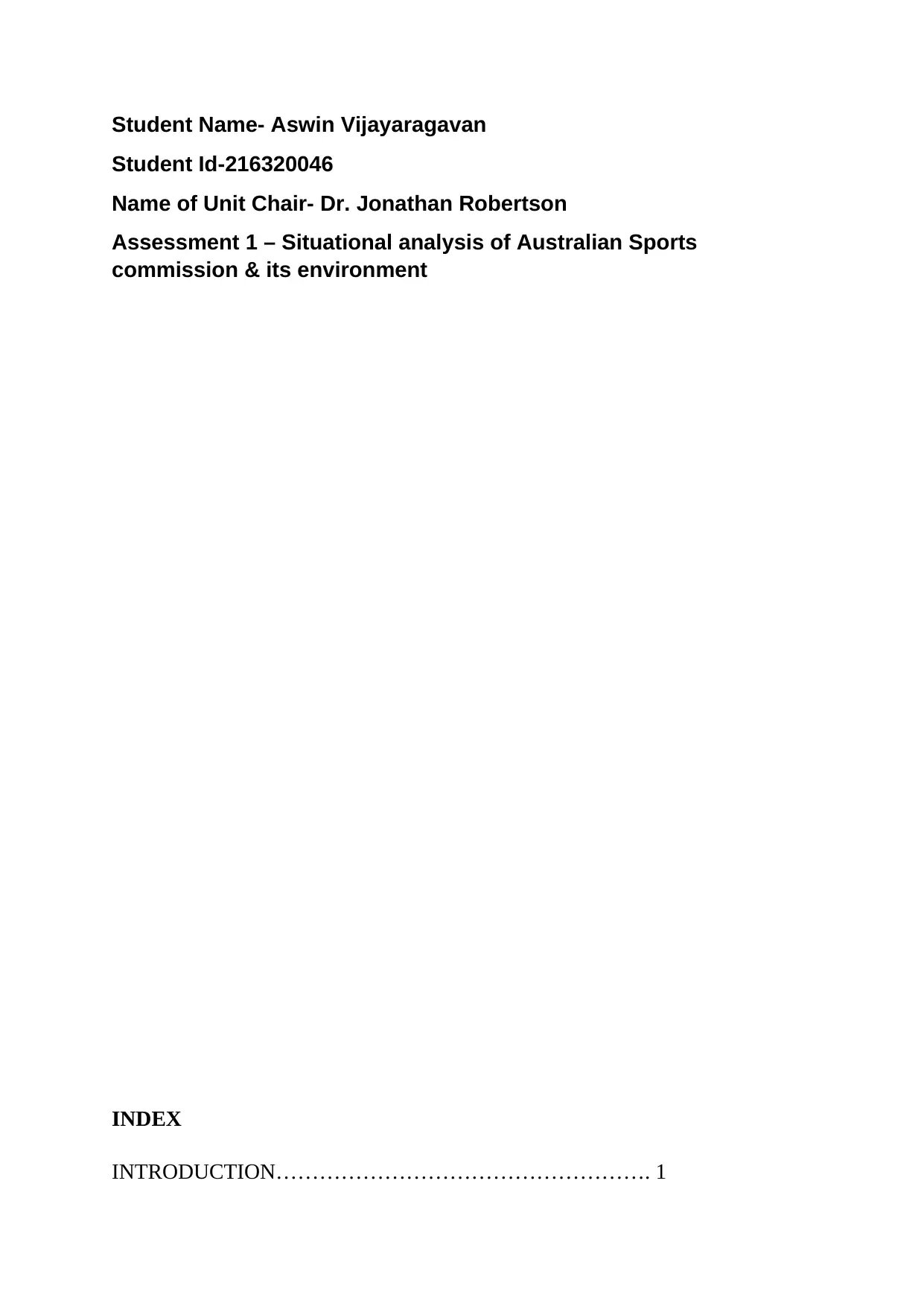
Student Name- Aswin Vijayaragavan
Student Id-216320046
Name of Unit Chair- Dr. Jonathan Robertson
Assessment 1 – Situational analysis of Australian Sports
commission & its environment
INDEX
INTRODUCTION……………………………………………. 1
Student Id-216320046
Name of Unit Chair- Dr. Jonathan Robertson
Assessment 1 – Situational analysis of Australian Sports
commission & its environment
INDEX
INTRODUCTION……………………………………………. 1
Secure Best Marks with AI Grader
Need help grading? Try our AI Grader for instant feedback on your assignments.
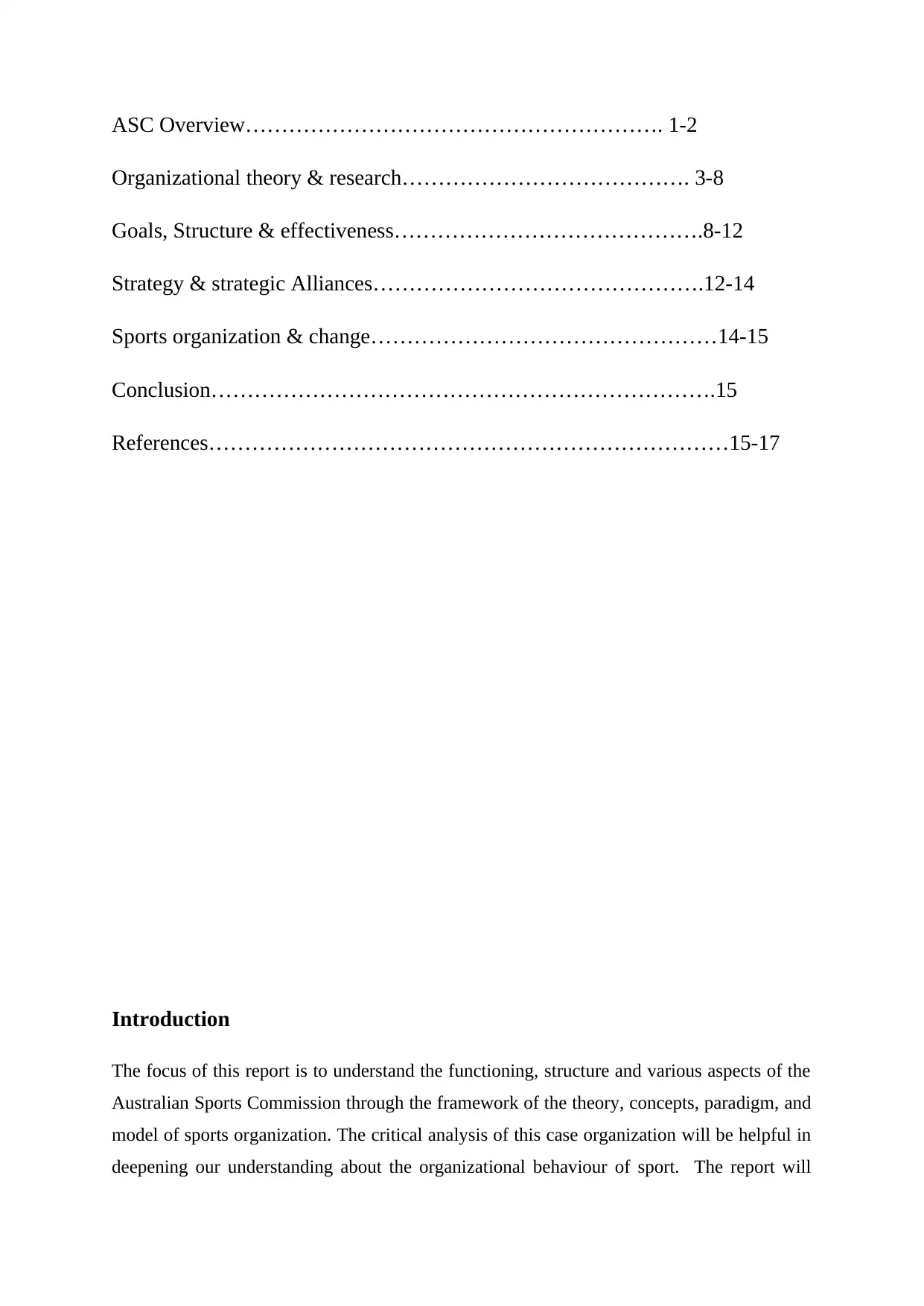
ASC Overview…………………………………………………. 1-2
Organizational theory & research…………………………………. 3-8
Goals, Structure & effectiveness…………………………………….8-12
Strategy & strategic Alliances……………………………………….12-14
Sports organization & change…………………………………………14-15
Conclusion…………………………………………………………….15
References………………………………………………………………15-17
Introduction
The focus of this report is to understand the functioning, structure and various aspects of the
Australian Sports Commission through the framework of the theory, concepts, paradigm, and
model of sports organization. The critical analysis of this case organization will be helpful in
deepening our understanding about the organizational behaviour of sport. The report will
Organizational theory & research…………………………………. 3-8
Goals, Structure & effectiveness…………………………………….8-12
Strategy & strategic Alliances……………………………………….12-14
Sports organization & change…………………………………………14-15
Conclusion…………………………………………………………….15
References………………………………………………………………15-17
Introduction
The focus of this report is to understand the functioning, structure and various aspects of the
Australian Sports Commission through the framework of the theory, concepts, paradigm, and
model of sports organization. The critical analysis of this case organization will be helpful in
deepening our understanding about the organizational behaviour of sport. The report will
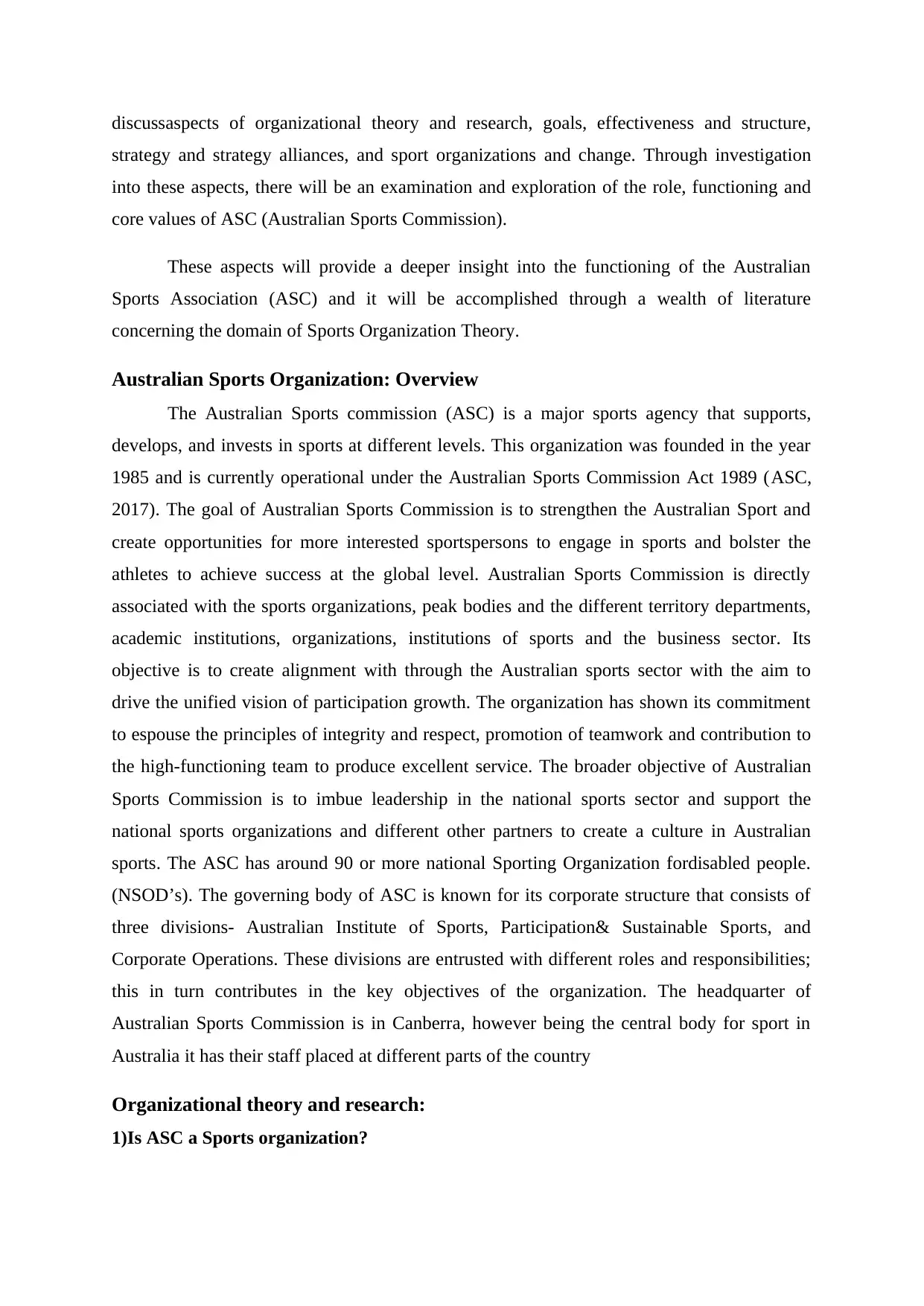
discussaspects of organizational theory and research, goals, effectiveness and structure,
strategy and strategy alliances, and sport organizations and change. Through investigation
into these aspects, there will be an examination and exploration of the role, functioning and
core values of ASC (Australian Sports Commission).
These aspects will provide a deeper insight into the functioning of the Australian
Sports Association (ASC) and it will be accomplished through a wealth of literature
concerning the domain of Sports Organization Theory.
Australian Sports Organization: Overview
The Australian Sports commission (ASC) is a major sports agency that supports,
develops, and invests in sports at different levels. This organization was founded in the year
1985 and is currently operational under the Australian Sports Commission Act 1989 (ASC,
2017). The goal of Australian Sports Commission is to strengthen the Australian Sport and
create opportunities for more interested sportspersons to engage in sports and bolster the
athletes to achieve success at the global level. Australian Sports Commission is directly
associated with the sports organizations, peak bodies and the different territory departments,
academic institutions, organizations, institutions of sports and the business sector. Its
objective is to create alignment with through the Australian sports sector with the aim to
drive the unified vision of participation growth. The organization has shown its commitment
to espouse the principles of integrity and respect, promotion of teamwork and contribution to
the high-functioning team to produce excellent service. The broader objective of Australian
Sports Commission is to imbue leadership in the national sports sector and support the
national sports organizations and different other partners to create a culture in Australian
sports. The ASC has around 90 or more national Sporting Organization fordisabled people.
(NSOD’s). The governing body of ASC is known for its corporate structure that consists of
three divisions- Australian Institute of Sports, Participation& Sustainable Sports, and
Corporate Operations. These divisions are entrusted with different roles and responsibilities;
this in turn contributes in the key objectives of the organization. The headquarter of
Australian Sports Commission is in Canberra, however being the central body for sport in
Australia it has their staff placed at different parts of the country
Organizational theory and research:
1)Is ASC a Sports organization?
strategy and strategy alliances, and sport organizations and change. Through investigation
into these aspects, there will be an examination and exploration of the role, functioning and
core values of ASC (Australian Sports Commission).
These aspects will provide a deeper insight into the functioning of the Australian
Sports Association (ASC) and it will be accomplished through a wealth of literature
concerning the domain of Sports Organization Theory.
Australian Sports Organization: Overview
The Australian Sports commission (ASC) is a major sports agency that supports,
develops, and invests in sports at different levels. This organization was founded in the year
1985 and is currently operational under the Australian Sports Commission Act 1989 (ASC,
2017). The goal of Australian Sports Commission is to strengthen the Australian Sport and
create opportunities for more interested sportspersons to engage in sports and bolster the
athletes to achieve success at the global level. Australian Sports Commission is directly
associated with the sports organizations, peak bodies and the different territory departments,
academic institutions, organizations, institutions of sports and the business sector. Its
objective is to create alignment with through the Australian sports sector with the aim to
drive the unified vision of participation growth. The organization has shown its commitment
to espouse the principles of integrity and respect, promotion of teamwork and contribution to
the high-functioning team to produce excellent service. The broader objective of Australian
Sports Commission is to imbue leadership in the national sports sector and support the
national sports organizations and different other partners to create a culture in Australian
sports. The ASC has around 90 or more national Sporting Organization fordisabled people.
(NSOD’s). The governing body of ASC is known for its corporate structure that consists of
three divisions- Australian Institute of Sports, Participation& Sustainable Sports, and
Corporate Operations. These divisions are entrusted with different roles and responsibilities;
this in turn contributes in the key objectives of the organization. The headquarter of
Australian Sports Commission is in Canberra, however being the central body for sport in
Australia it has their staff placed at different parts of the country
Organizational theory and research:
1)Is ASC a Sports organization?
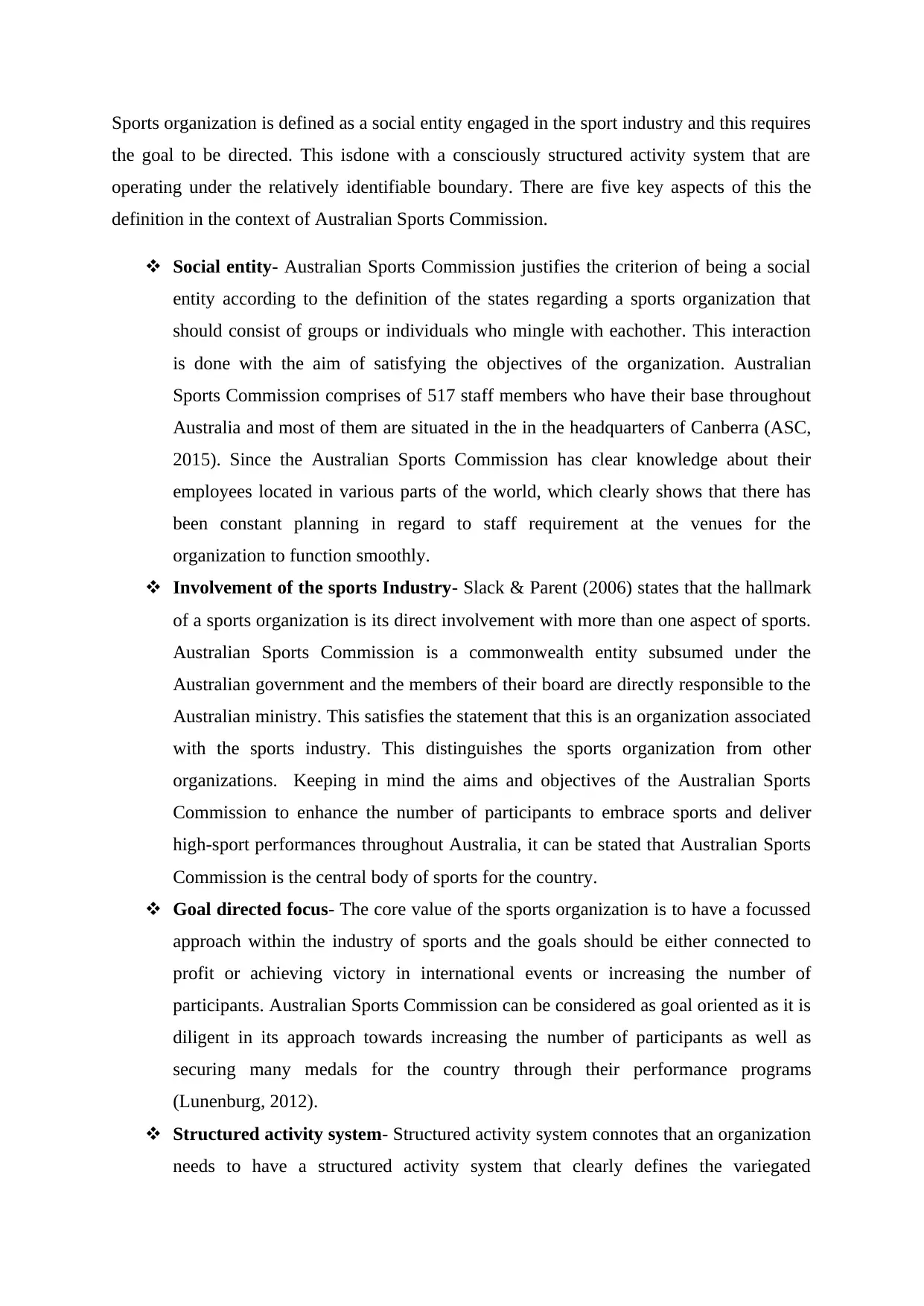
Sports organization is defined as a social entity engaged in the sport industry and this requires
the goal to be directed. This isdone with a consciously structured activity system that are
operating under the relatively identifiable boundary. There are five key aspects of this the
definition in the context of Australian Sports Commission.
Social entity- Australian Sports Commission justifies the criterion of being a social
entity according to the definition of the states regarding a sports organization that
should consist of groups or individuals who mingle with eachother. This interaction
is done with the aim of satisfying the objectives of the organization. Australian
Sports Commission comprises of 517 staff members who have their base throughout
Australia and most of them are situated in the in the headquarters of Canberra (ASC,
2015). Since the Australian Sports Commission has clear knowledge about their
employees located in various parts of the world, which clearly shows that there has
been constant planning in regard to staff requirement at the venues for the
organization to function smoothly.
Involvement of the sports Industry- Slack & Parent (2006) states that the hallmark
of a sports organization is its direct involvement with more than one aspect of sports.
Australian Sports Commission is a commonwealth entity subsumed under the
Australian government and the members of their board are directly responsible to the
Australian ministry. This satisfies the statement that this is an organization associated
with the sports industry. This distinguishes the sports organization from other
organizations. Keeping in mind the aims and objectives of the Australian Sports
Commission to enhance the number of participants to embrace sports and deliver
high-sport performances throughout Australia, it can be stated that Australian Sports
Commission is the central body of sports for the country.
Goal directed focus- The core value of the sports organization is to have a focussed
approach within the industry of sports and the goals should be either connected to
profit or achieving victory in international events or increasing the number of
participants. Australian Sports Commission can be considered as goal oriented as it is
diligent in its approach towards increasing the number of participants as well as
securing many medals for the country through their performance programs
(Lunenburg, 2012).
Structured activity system- Structured activity system connotes that an organization
needs to have a structured activity system that clearly defines the variegated
the goal to be directed. This isdone with a consciously structured activity system that are
operating under the relatively identifiable boundary. There are five key aspects of this the
definition in the context of Australian Sports Commission.
Social entity- Australian Sports Commission justifies the criterion of being a social
entity according to the definition of the states regarding a sports organization that
should consist of groups or individuals who mingle with eachother. This interaction
is done with the aim of satisfying the objectives of the organization. Australian
Sports Commission comprises of 517 staff members who have their base throughout
Australia and most of them are situated in the in the headquarters of Canberra (ASC,
2015). Since the Australian Sports Commission has clear knowledge about their
employees located in various parts of the world, which clearly shows that there has
been constant planning in regard to staff requirement at the venues for the
organization to function smoothly.
Involvement of the sports Industry- Slack & Parent (2006) states that the hallmark
of a sports organization is its direct involvement with more than one aspect of sports.
Australian Sports Commission is a commonwealth entity subsumed under the
Australian government and the members of their board are directly responsible to the
Australian ministry. This satisfies the statement that this is an organization associated
with the sports industry. This distinguishes the sports organization from other
organizations. Keeping in mind the aims and objectives of the Australian Sports
Commission to enhance the number of participants to embrace sports and deliver
high-sport performances throughout Australia, it can be stated that Australian Sports
Commission is the central body of sports for the country.
Goal directed focus- The core value of the sports organization is to have a focussed
approach within the industry of sports and the goals should be either connected to
profit or achieving victory in international events or increasing the number of
participants. Australian Sports Commission can be considered as goal oriented as it is
diligent in its approach towards increasing the number of participants as well as
securing many medals for the country through their performance programs
(Lunenburg, 2012).
Structured activity system- Structured activity system connotes that an organization
needs to have a structured activity system that clearly defines the variegated
Secure Best Marks with AI Grader
Need help grading? Try our AI Grader for instant feedback on your assignments.
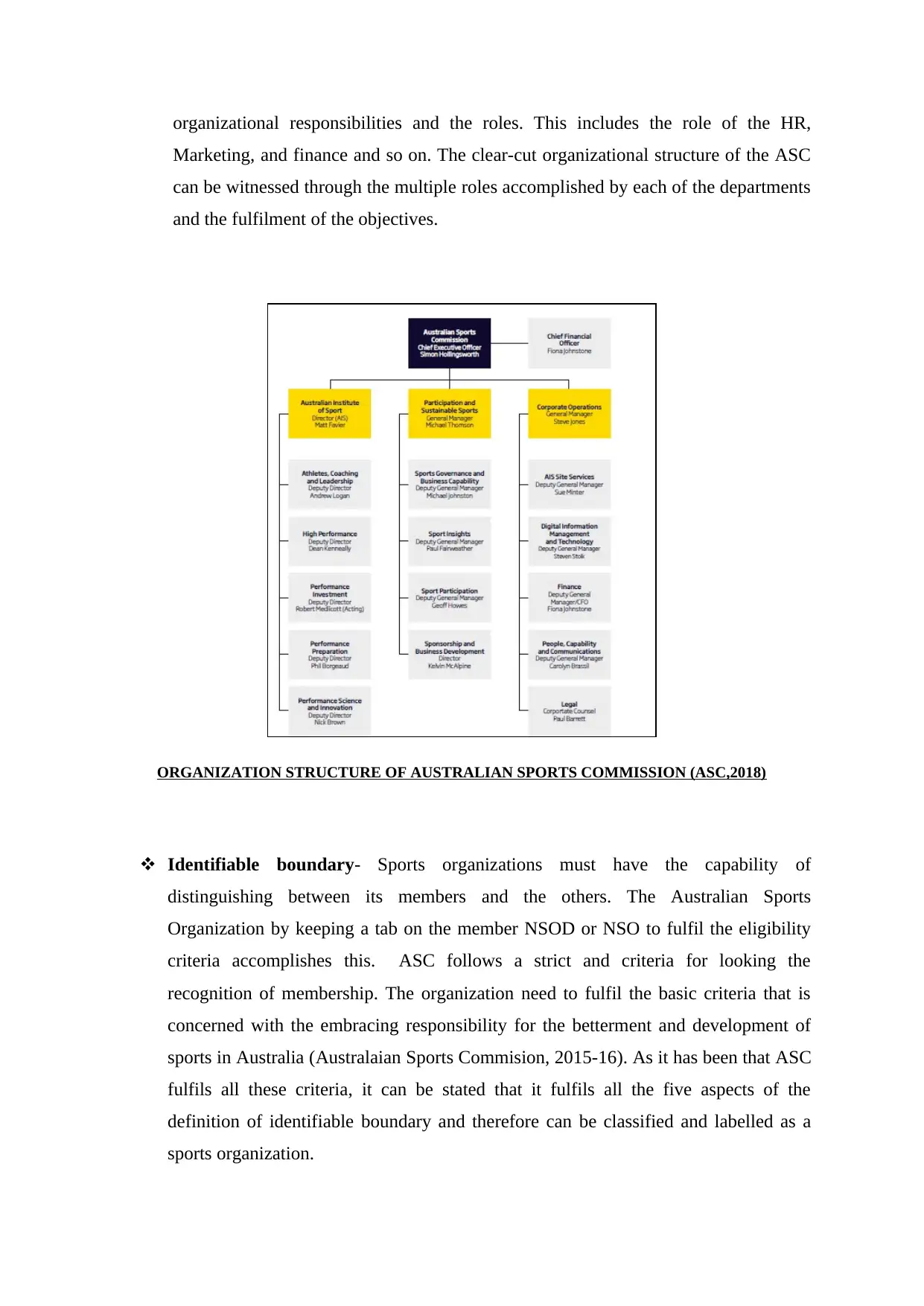
organizational responsibilities and the roles. This includes the role of the HR,
Marketing, and finance and so on. The clear-cut organizational structure of the ASC
can be witnessed through the multiple roles accomplished by each of the departments
and the fulfilment of the objectives.
ORGANIZATION STRUCTURE OF AUSTRALIAN SPORTS COMMISSION (ASC,2018)
Identifiable boundary- Sports organizations must have the capability of
distinguishing between its members and the others. The Australian Sports
Organization by keeping a tab on the member NSOD or NSO to fulfil the eligibility
criteria accomplishes this. ASC follows a strict and criteria for looking the
recognition of membership. The organization need to fulfil the basic criteria that is
concerned with the embracing responsibility for the betterment and development of
sports in Australia (Australaian Sports Commision, 2015-16). As it has been that ASC
fulfils all these criteria, it can be stated that it fulfils all the five aspects of the
definition of identifiable boundary and therefore can be classified and labelled as a
sports organization.
Marketing, and finance and so on. The clear-cut organizational structure of the ASC
can be witnessed through the multiple roles accomplished by each of the departments
and the fulfilment of the objectives.
ORGANIZATION STRUCTURE OF AUSTRALIAN SPORTS COMMISSION (ASC,2018)
Identifiable boundary- Sports organizations must have the capability of
distinguishing between its members and the others. The Australian Sports
Organization by keeping a tab on the member NSOD or NSO to fulfil the eligibility
criteria accomplishes this. ASC follows a strict and criteria for looking the
recognition of membership. The organization need to fulfil the basic criteria that is
concerned with the embracing responsibility for the betterment and development of
sports in Australia (Australaian Sports Commision, 2015-16). As it has been that ASC
fulfils all these criteria, it can be stated that it fulfils all the five aspects of the
definition of identifiable boundary and therefore can be classified and labelled as a
sports organization.
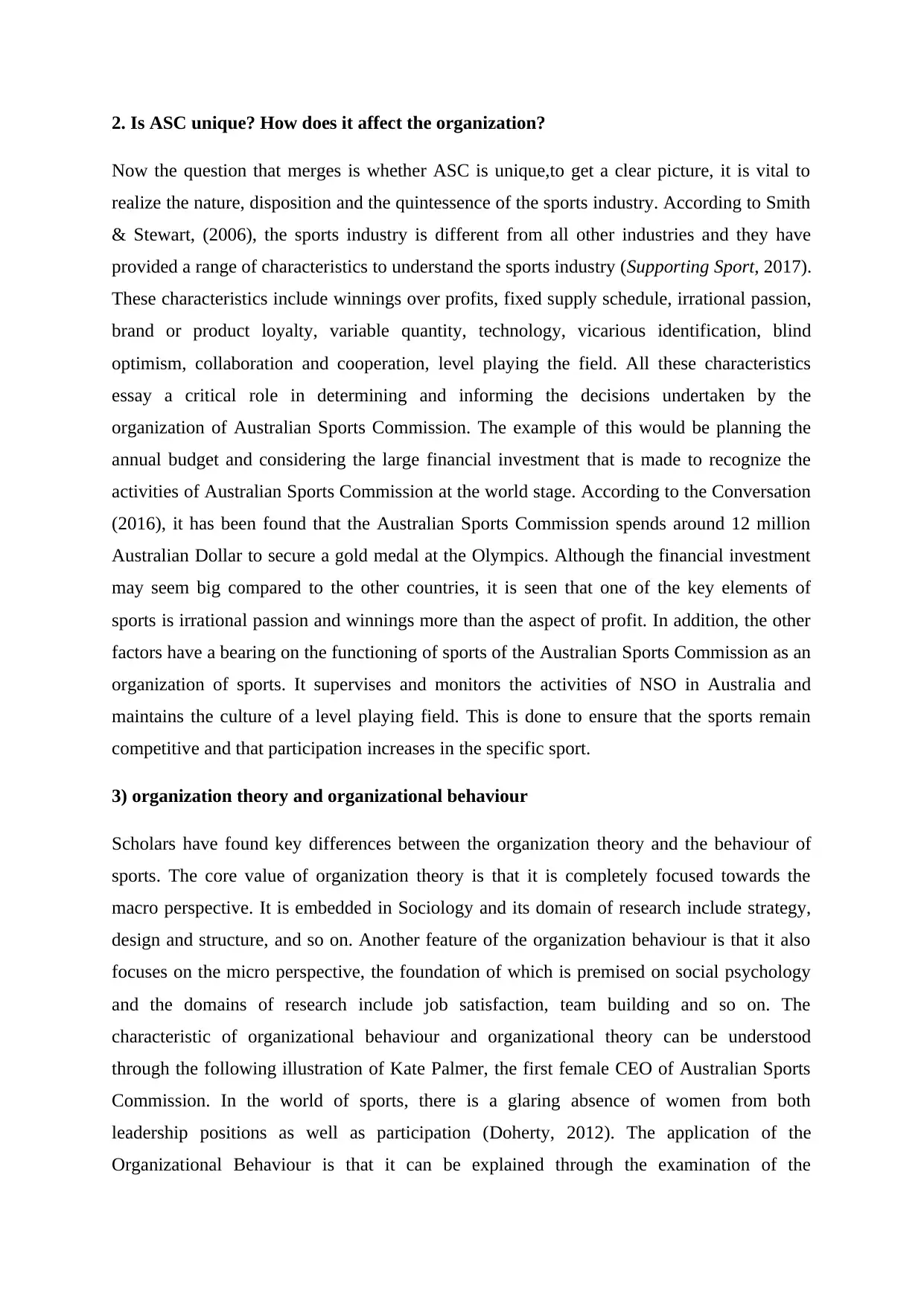
2. Is ASC unique? How does it affect the organization?
Now the question that merges is whether ASC is unique,to get a clear picture, it is vital to
realize the nature, disposition and the quintessence of the sports industry. According to Smith
& Stewart, (2006), the sports industry is different from all other industries and they have
provided a range of characteristics to understand the sports industry (Supporting Sport, 2017).
These characteristics include winnings over profits, fixed supply schedule, irrational passion,
brand or product loyalty, variable quantity, technology, vicarious identification, blind
optimism, collaboration and cooperation, level playing the field. All these characteristics
essay a critical role in determining and informing the decisions undertaken by the
organization of Australian Sports Commission. The example of this would be planning the
annual budget and considering the large financial investment that is made to recognize the
activities of Australian Sports Commission at the world stage. According to the Conversation
(2016), it has been found that the Australian Sports Commission spends around 12 million
Australian Dollar to secure a gold medal at the Olympics. Although the financial investment
may seem big compared to the other countries, it is seen that one of the key elements of
sports is irrational passion and winnings more than the aspect of profit. In addition, the other
factors have a bearing on the functioning of sports of the Australian Sports Commission as an
organization of sports. It supervises and monitors the activities of NSO in Australia and
maintains the culture of a level playing field. This is done to ensure that the sports remain
competitive and that participation increases in the specific sport.
3) organization theory and organizational behaviour
Scholars have found key differences between the organization theory and the behaviour of
sports. The core value of organization theory is that it is completely focused towards the
macro perspective. It is embedded in Sociology and its domain of research include strategy,
design and structure, and so on. Another feature of the organization behaviour is that it also
focuses on the micro perspective, the foundation of which is premised on social psychology
and the domains of research include job satisfaction, team building and so on. The
characteristic of organizational behaviour and organizational theory can be understood
through the following illustration of Kate Palmer, the first female CEO of Australian Sports
Commission. In the world of sports, there is a glaring absence of women from both
leadership positions as well as participation (Doherty, 2012). The application of the
Organizational Behaviour is that it can be explained through the examination of the
Now the question that merges is whether ASC is unique,to get a clear picture, it is vital to
realize the nature, disposition and the quintessence of the sports industry. According to Smith
& Stewart, (2006), the sports industry is different from all other industries and they have
provided a range of characteristics to understand the sports industry (Supporting Sport, 2017).
These characteristics include winnings over profits, fixed supply schedule, irrational passion,
brand or product loyalty, variable quantity, technology, vicarious identification, blind
optimism, collaboration and cooperation, level playing the field. All these characteristics
essay a critical role in determining and informing the decisions undertaken by the
organization of Australian Sports Commission. The example of this would be planning the
annual budget and considering the large financial investment that is made to recognize the
activities of Australian Sports Commission at the world stage. According to the Conversation
(2016), it has been found that the Australian Sports Commission spends around 12 million
Australian Dollar to secure a gold medal at the Olympics. Although the financial investment
may seem big compared to the other countries, it is seen that one of the key elements of
sports is irrational passion and winnings more than the aspect of profit. In addition, the other
factors have a bearing on the functioning of sports of the Australian Sports Commission as an
organization of sports. It supervises and monitors the activities of NSO in Australia and
maintains the culture of a level playing field. This is done to ensure that the sports remain
competitive and that participation increases in the specific sport.
3) organization theory and organizational behaviour
Scholars have found key differences between the organization theory and the behaviour of
sports. The core value of organization theory is that it is completely focused towards the
macro perspective. It is embedded in Sociology and its domain of research include strategy,
design and structure, and so on. Another feature of the organization behaviour is that it also
focuses on the micro perspective, the foundation of which is premised on social psychology
and the domains of research include job satisfaction, team building and so on. The
characteristic of organizational behaviour and organizational theory can be understood
through the following illustration of Kate Palmer, the first female CEO of Australian Sports
Commission. In the world of sports, there is a glaring absence of women from both
leadership positions as well as participation (Doherty, 2012). The application of the
Organizational Behaviour is that it can be explained through the examination of the
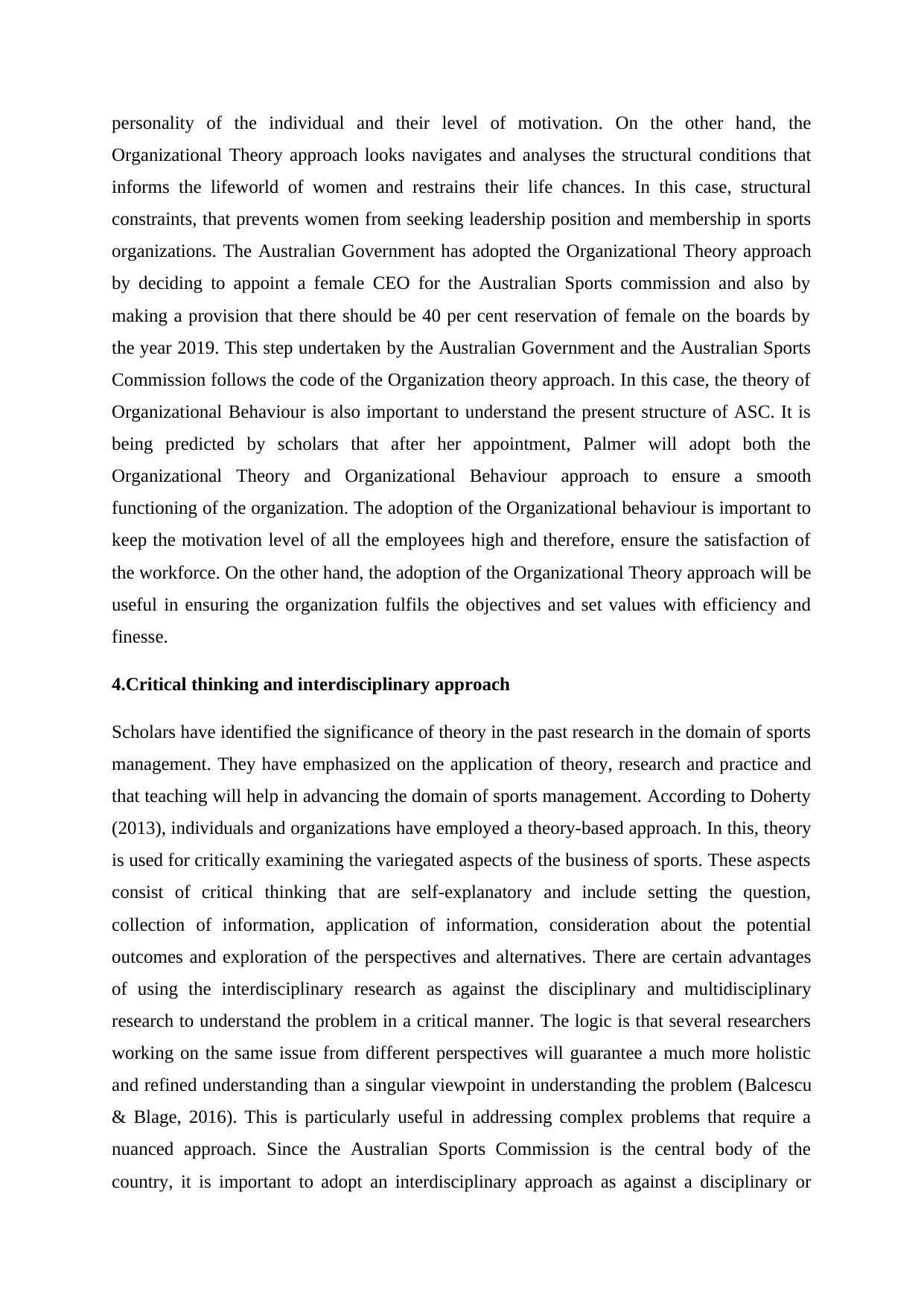
personality of the individual and their level of motivation. On the other hand, the
Organizational Theory approach looks navigates and analyses the structural conditions that
informs the lifeworld of women and restrains their life chances. In this case, structural
constraints, that prevents women from seeking leadership position and membership in sports
organizations. The Australian Government has adopted the Organizational Theory approach
by deciding to appoint a female CEO for the Australian Sports commission and also by
making a provision that there should be 40 per cent reservation of female on the boards by
the year 2019. This step undertaken by the Australian Government and the Australian Sports
Commission follows the code of the Organization theory approach. In this case, the theory of
Organizational Behaviour is also important to understand the present structure of ASC. It is
being predicted by scholars that after her appointment, Palmer will adopt both the
Organizational Theory and Organizational Behaviour approach to ensure a smooth
functioning of the organization. The adoption of the Organizational behaviour is important to
keep the motivation level of all the employees high and therefore, ensure the satisfaction of
the workforce. On the other hand, the adoption of the Organizational Theory approach will be
useful in ensuring the organization fulfils the objectives and set values with efficiency and
finesse.
4.Critical thinking and interdisciplinary approach
Scholars have identified the significance of theory in the past research in the domain of sports
management. They have emphasized on the application of theory, research and practice and
that teaching will help in advancing the domain of sports management. According to Doherty
(2013), individuals and organizations have employed a theory-based approach. In this, theory
is used for critically examining the variegated aspects of the business of sports. These aspects
consist of critical thinking that are self-explanatory and include setting the question,
collection of information, application of information, consideration about the potential
outcomes and exploration of the perspectives and alternatives. There are certain advantages
of using the interdisciplinary research as against the disciplinary and multidisciplinary
research to understand the problem in a critical manner. The logic is that several researchers
working on the same issue from different perspectives will guarantee a much more holistic
and refined understanding than a singular viewpoint in understanding the problem (Balcescu
& Blage, 2016). This is particularly useful in addressing complex problems that require a
nuanced approach. Since the Australian Sports Commission is the central body of the
country, it is important to adopt an interdisciplinary approach as against a disciplinary or
Organizational Theory approach looks navigates and analyses the structural conditions that
informs the lifeworld of women and restrains their life chances. In this case, structural
constraints, that prevents women from seeking leadership position and membership in sports
organizations. The Australian Government has adopted the Organizational Theory approach
by deciding to appoint a female CEO for the Australian Sports commission and also by
making a provision that there should be 40 per cent reservation of female on the boards by
the year 2019. This step undertaken by the Australian Government and the Australian Sports
Commission follows the code of the Organization theory approach. In this case, the theory of
Organizational Behaviour is also important to understand the present structure of ASC. It is
being predicted by scholars that after her appointment, Palmer will adopt both the
Organizational Theory and Organizational Behaviour approach to ensure a smooth
functioning of the organization. The adoption of the Organizational behaviour is important to
keep the motivation level of all the employees high and therefore, ensure the satisfaction of
the workforce. On the other hand, the adoption of the Organizational Theory approach will be
useful in ensuring the organization fulfils the objectives and set values with efficiency and
finesse.
4.Critical thinking and interdisciplinary approach
Scholars have identified the significance of theory in the past research in the domain of sports
management. They have emphasized on the application of theory, research and practice and
that teaching will help in advancing the domain of sports management. According to Doherty
(2013), individuals and organizations have employed a theory-based approach. In this, theory
is used for critically examining the variegated aspects of the business of sports. These aspects
consist of critical thinking that are self-explanatory and include setting the question,
collection of information, application of information, consideration about the potential
outcomes and exploration of the perspectives and alternatives. There are certain advantages
of using the interdisciplinary research as against the disciplinary and multidisciplinary
research to understand the problem in a critical manner. The logic is that several researchers
working on the same issue from different perspectives will guarantee a much more holistic
and refined understanding than a singular viewpoint in understanding the problem (Balcescu
& Blage, 2016). This is particularly useful in addressing complex problems that require a
nuanced approach. Since the Australian Sports Commission is the central body of the
country, it is important to adopt an interdisciplinary approach as against a disciplinary or
Paraphrase This Document
Need a fresh take? Get an instant paraphrase of this document with our AI Paraphraser
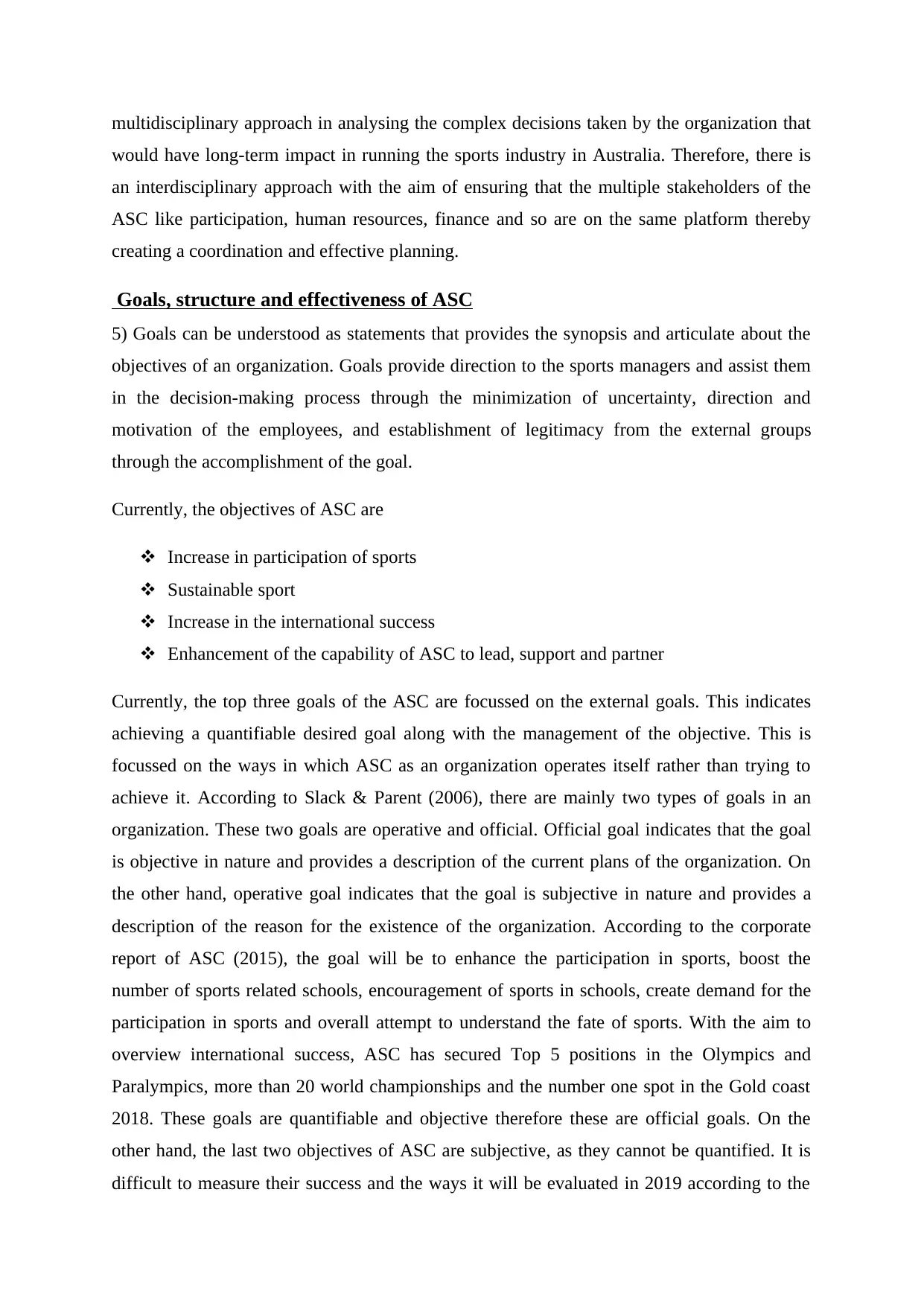
multidisciplinary approach in analysing the complex decisions taken by the organization that
would have long-term impact in running the sports industry in Australia. Therefore, there is
an interdisciplinary approach with the aim of ensuring that the multiple stakeholders of the
ASC like participation, human resources, finance and so are on the same platform thereby
creating a coordination and effective planning.
Goals, structure and effectiveness of ASC
5) Goals can be understood as statements that provides the synopsis and articulate about the
objectives of an organization. Goals provide direction to the sports managers and assist them
in the decision-making process through the minimization of uncertainty, direction and
motivation of the employees, and establishment of legitimacy from the external groups
through the accomplishment of the goal.
Currently, the objectives of ASC are
Increase in participation of sports
Sustainable sport
Increase in the international success
Enhancement of the capability of ASC to lead, support and partner
Currently, the top three goals of the ASC are focussed on the external goals. This indicates
achieving a quantifiable desired goal along with the management of the objective. This is
focussed on the ways in which ASC as an organization operates itself rather than trying to
achieve it. According to Slack & Parent (2006), there are mainly two types of goals in an
organization. These two goals are operative and official. Official goal indicates that the goal
is objective in nature and provides a description of the current plans of the organization. On
the other hand, operative goal indicates that the goal is subjective in nature and provides a
description of the reason for the existence of the organization. According to the corporate
report of ASC (2015), the goal will be to enhance the participation in sports, boost the
number of sports related schools, encouragement of sports in schools, create demand for the
participation in sports and overall attempt to understand the fate of sports. With the aim to
overview international success, ASC has secured Top 5 positions in the Olympics and
Paralympics, more than 20 world championships and the number one spot in the Gold coast
2018. These goals are quantifiable and objective therefore these are official goals. On the
other hand, the last two objectives of ASC are subjective, as they cannot be quantified. It is
difficult to measure their success and the ways it will be evaluated in 2019 according to the
would have long-term impact in running the sports industry in Australia. Therefore, there is
an interdisciplinary approach with the aim of ensuring that the multiple stakeholders of the
ASC like participation, human resources, finance and so are on the same platform thereby
creating a coordination and effective planning.
Goals, structure and effectiveness of ASC
5) Goals can be understood as statements that provides the synopsis and articulate about the
objectives of an organization. Goals provide direction to the sports managers and assist them
in the decision-making process through the minimization of uncertainty, direction and
motivation of the employees, and establishment of legitimacy from the external groups
through the accomplishment of the goal.
Currently, the objectives of ASC are
Increase in participation of sports
Sustainable sport
Increase in the international success
Enhancement of the capability of ASC to lead, support and partner
Currently, the top three goals of the ASC are focussed on the external goals. This indicates
achieving a quantifiable desired goal along with the management of the objective. This is
focussed on the ways in which ASC as an organization operates itself rather than trying to
achieve it. According to Slack & Parent (2006), there are mainly two types of goals in an
organization. These two goals are operative and official. Official goal indicates that the goal
is objective in nature and provides a description of the current plans of the organization. On
the other hand, operative goal indicates that the goal is subjective in nature and provides a
description of the reason for the existence of the organization. According to the corporate
report of ASC (2015), the goal will be to enhance the participation in sports, boost the
number of sports related schools, encouragement of sports in schools, create demand for the
participation in sports and overall attempt to understand the fate of sports. With the aim to
overview international success, ASC has secured Top 5 positions in the Olympics and
Paralympics, more than 20 world championships and the number one spot in the Gold coast
2018. These goals are quantifiable and objective therefore these are official goals. On the
other hand, the last two objectives of ASC are subjective, as they cannot be quantified. It is
difficult to measure their success and the ways it will be evaluated in 2019 according to the
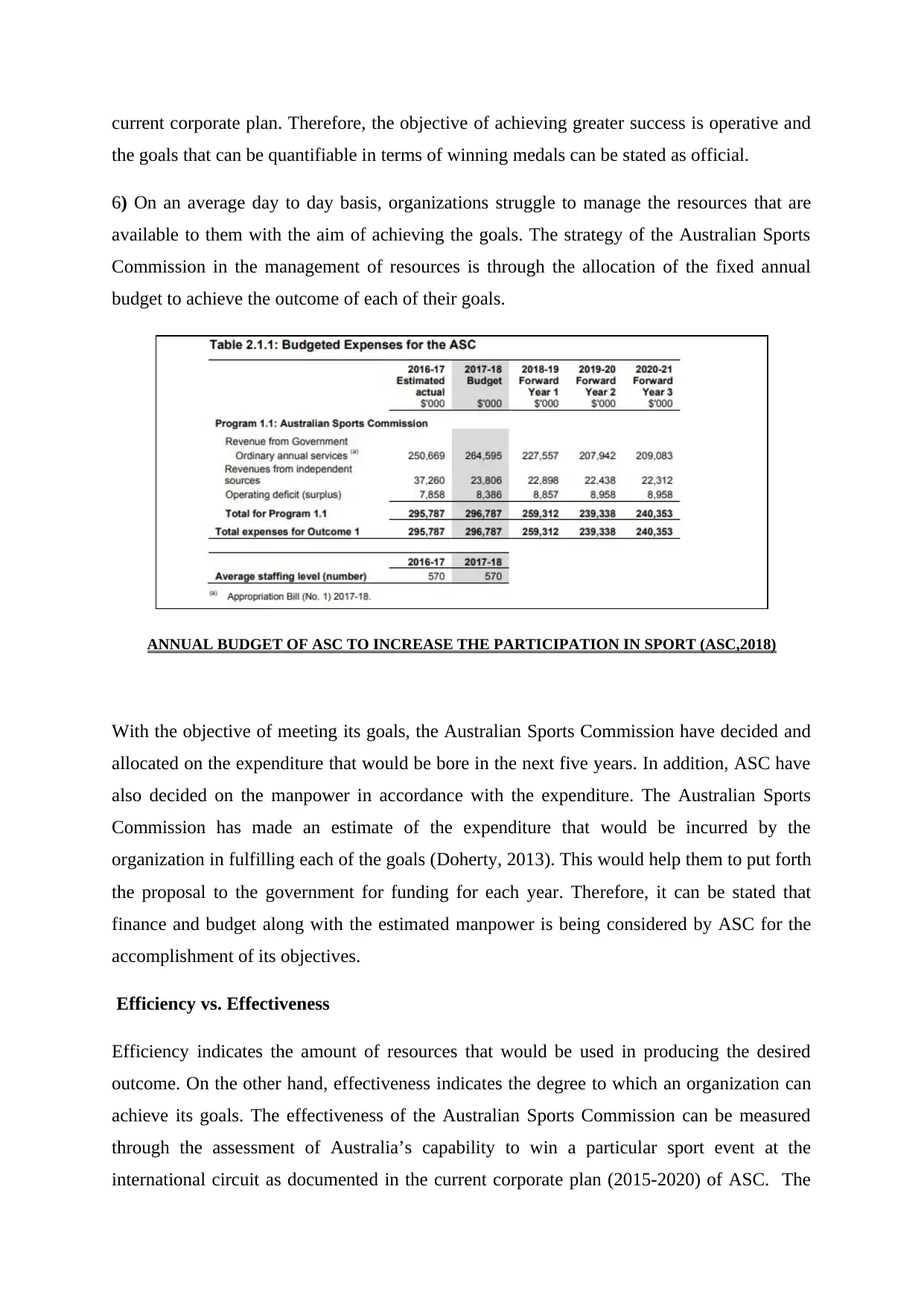
current corporate plan. Therefore, the objective of achieving greater success is operative and
the goals that can be quantifiable in terms of winning medals can be stated as official.
6) On an average day to day basis, organizations struggle to manage the resources that are
available to them with the aim of achieving the goals. The strategy of the Australian Sports
Commission in the management of resources is through the allocation of the fixed annual
budget to achieve the outcome of each of their goals.
ANNUAL BUDGET OF ASC TO INCREASE THE PARTICIPATION IN SPORT (ASC,2018)
With the objective of meeting its goals, the Australian Sports Commission have decided and
allocated on the expenditure that would be bore in the next five years. In addition, ASC have
also decided on the manpower in accordance with the expenditure. The Australian Sports
Commission has made an estimate of the expenditure that would be incurred by the
organization in fulfilling each of the goals (Doherty, 2013). This would help them to put forth
the proposal to the government for funding for each year. Therefore, it can be stated that
finance and budget along with the estimated manpower is being considered by ASC for the
accomplishment of its objectives.
Efficiency vs. Effectiveness
Efficiency indicates the amount of resources that would be used in producing the desired
outcome. On the other hand, effectiveness indicates the degree to which an organization can
achieve its goals. The effectiveness of the Australian Sports Commission can be measured
through the assessment of Australia’s capability to win a particular sport event at the
international circuit as documented in the current corporate plan (2015-2020) of ASC. The
the goals that can be quantifiable in terms of winning medals can be stated as official.
6) On an average day to day basis, organizations struggle to manage the resources that are
available to them with the aim of achieving the goals. The strategy of the Australian Sports
Commission in the management of resources is through the allocation of the fixed annual
budget to achieve the outcome of each of their goals.
ANNUAL BUDGET OF ASC TO INCREASE THE PARTICIPATION IN SPORT (ASC,2018)
With the objective of meeting its goals, the Australian Sports Commission have decided and
allocated on the expenditure that would be bore in the next five years. In addition, ASC have
also decided on the manpower in accordance with the expenditure. The Australian Sports
Commission has made an estimate of the expenditure that would be incurred by the
organization in fulfilling each of the goals (Doherty, 2013). This would help them to put forth
the proposal to the government for funding for each year. Therefore, it can be stated that
finance and budget along with the estimated manpower is being considered by ASC for the
accomplishment of its objectives.
Efficiency vs. Effectiveness
Efficiency indicates the amount of resources that would be used in producing the desired
outcome. On the other hand, effectiveness indicates the degree to which an organization can
achieve its goals. The effectiveness of the Australian Sports Commission can be measured
through the assessment of Australia’s capability to win a particular sport event at the
international circuit as documented in the current corporate plan (2015-2020) of ASC. The
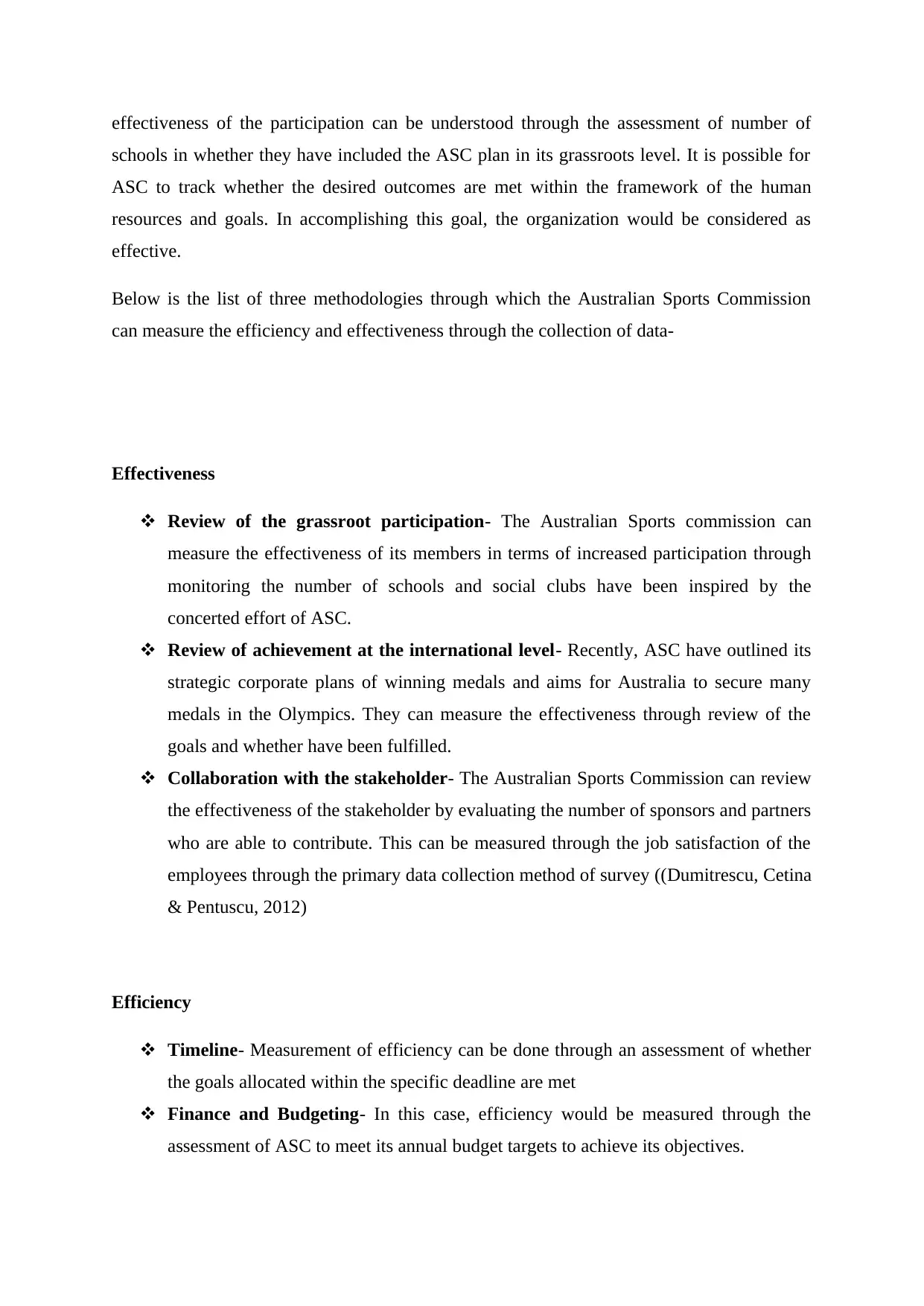
effectiveness of the participation can be understood through the assessment of number of
schools in whether they have included the ASC plan in its grassroots level. It is possible for
ASC to track whether the desired outcomes are met within the framework of the human
resources and goals. In accomplishing this goal, the organization would be considered as
effective.
Below is the list of three methodologies through which the Australian Sports Commission
can measure the efficiency and effectiveness through the collection of data-
Effectiveness
Review of the grassroot participation- The Australian Sports commission can
measure the effectiveness of its members in terms of increased participation through
monitoring the number of schools and social clubs have been inspired by the
concerted effort of ASC.
Review of achievement at the international level- Recently, ASC have outlined its
strategic corporate plans of winning medals and aims for Australia to secure many
medals in the Olympics. They can measure the effectiveness through review of the
goals and whether have been fulfilled.
Collaboration with the stakeholder- The Australian Sports Commission can review
the effectiveness of the stakeholder by evaluating the number of sponsors and partners
who are able to contribute. This can be measured through the job satisfaction of the
employees through the primary data collection method of survey ((Dumitrescu, Cetina
& Pentuscu, 2012)
Efficiency
Timeline- Measurement of efficiency can be done through an assessment of whether
the goals allocated within the specific deadline are met
Finance and Budgeting- In this case, efficiency would be measured through the
assessment of ASC to meet its annual budget targets to achieve its objectives.
schools in whether they have included the ASC plan in its grassroots level. It is possible for
ASC to track whether the desired outcomes are met within the framework of the human
resources and goals. In accomplishing this goal, the organization would be considered as
effective.
Below is the list of three methodologies through which the Australian Sports Commission
can measure the efficiency and effectiveness through the collection of data-
Effectiveness
Review of the grassroot participation- The Australian Sports commission can
measure the effectiveness of its members in terms of increased participation through
monitoring the number of schools and social clubs have been inspired by the
concerted effort of ASC.
Review of achievement at the international level- Recently, ASC have outlined its
strategic corporate plans of winning medals and aims for Australia to secure many
medals in the Olympics. They can measure the effectiveness through review of the
goals and whether have been fulfilled.
Collaboration with the stakeholder- The Australian Sports Commission can review
the effectiveness of the stakeholder by evaluating the number of sponsors and partners
who are able to contribute. This can be measured through the job satisfaction of the
employees through the primary data collection method of survey ((Dumitrescu, Cetina
& Pentuscu, 2012)
Efficiency
Timeline- Measurement of efficiency can be done through an assessment of whether
the goals allocated within the specific deadline are met
Finance and Budgeting- In this case, efficiency would be measured through the
assessment of ASC to meet its annual budget targets to achieve its objectives.
Secure Best Marks with AI Grader
Need help grading? Try our AI Grader for instant feedback on your assignments.
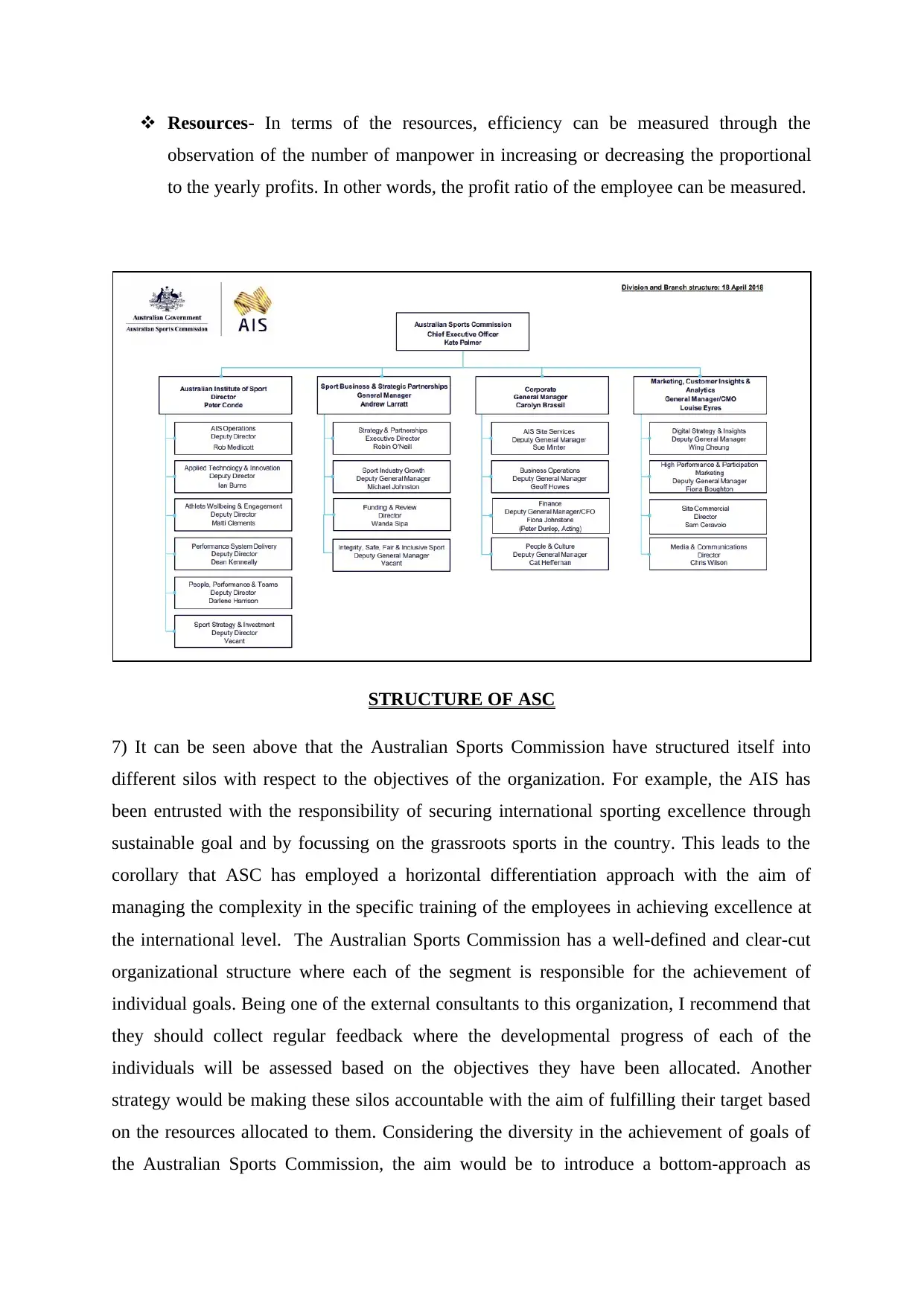
Resources- In terms of the resources, efficiency can be measured through the
observation of the number of manpower in increasing or decreasing the proportional
to the yearly profits. In other words, the profit ratio of the employee can be measured.
STRUCTURE OF ASC
7) It can be seen above that the Australian Sports Commission have structured itself into
different silos with respect to the objectives of the organization. For example, the AIS has
been entrusted with the responsibility of securing international sporting excellence through
sustainable goal and by focussing on the grassroots sports in the country. This leads to the
corollary that ASC has employed a horizontal differentiation approach with the aim of
managing the complexity in the specific training of the employees in achieving excellence at
the international level. The Australian Sports Commission has a well-defined and clear-cut
organizational structure where each of the segment is responsible for the achievement of
individual goals. Being one of the external consultants to this organization, I recommend that
they should collect regular feedback where the developmental progress of each of the
individuals will be assessed based on the objectives they have been allocated. Another
strategy would be making these silos accountable with the aim of fulfilling their target based
on the resources allocated to them. Considering the diversity in the achievement of goals of
the Australian Sports Commission, the aim would be to introduce a bottom-approach as
observation of the number of manpower in increasing or decreasing the proportional
to the yearly profits. In other words, the profit ratio of the employee can be measured.
STRUCTURE OF ASC
7) It can be seen above that the Australian Sports Commission have structured itself into
different silos with respect to the objectives of the organization. For example, the AIS has
been entrusted with the responsibility of securing international sporting excellence through
sustainable goal and by focussing on the grassroots sports in the country. This leads to the
corollary that ASC has employed a horizontal differentiation approach with the aim of
managing the complexity in the specific training of the employees in achieving excellence at
the international level. The Australian Sports Commission has a well-defined and clear-cut
organizational structure where each of the segment is responsible for the achievement of
individual goals. Being one of the external consultants to this organization, I recommend that
they should collect regular feedback where the developmental progress of each of the
individuals will be assessed based on the objectives they have been allocated. Another
strategy would be making these silos accountable with the aim of fulfilling their target based
on the resources allocated to them. Considering the diversity in the achievement of goals of
the Australian Sports Commission, the aim would be to introduce a bottom-approach as
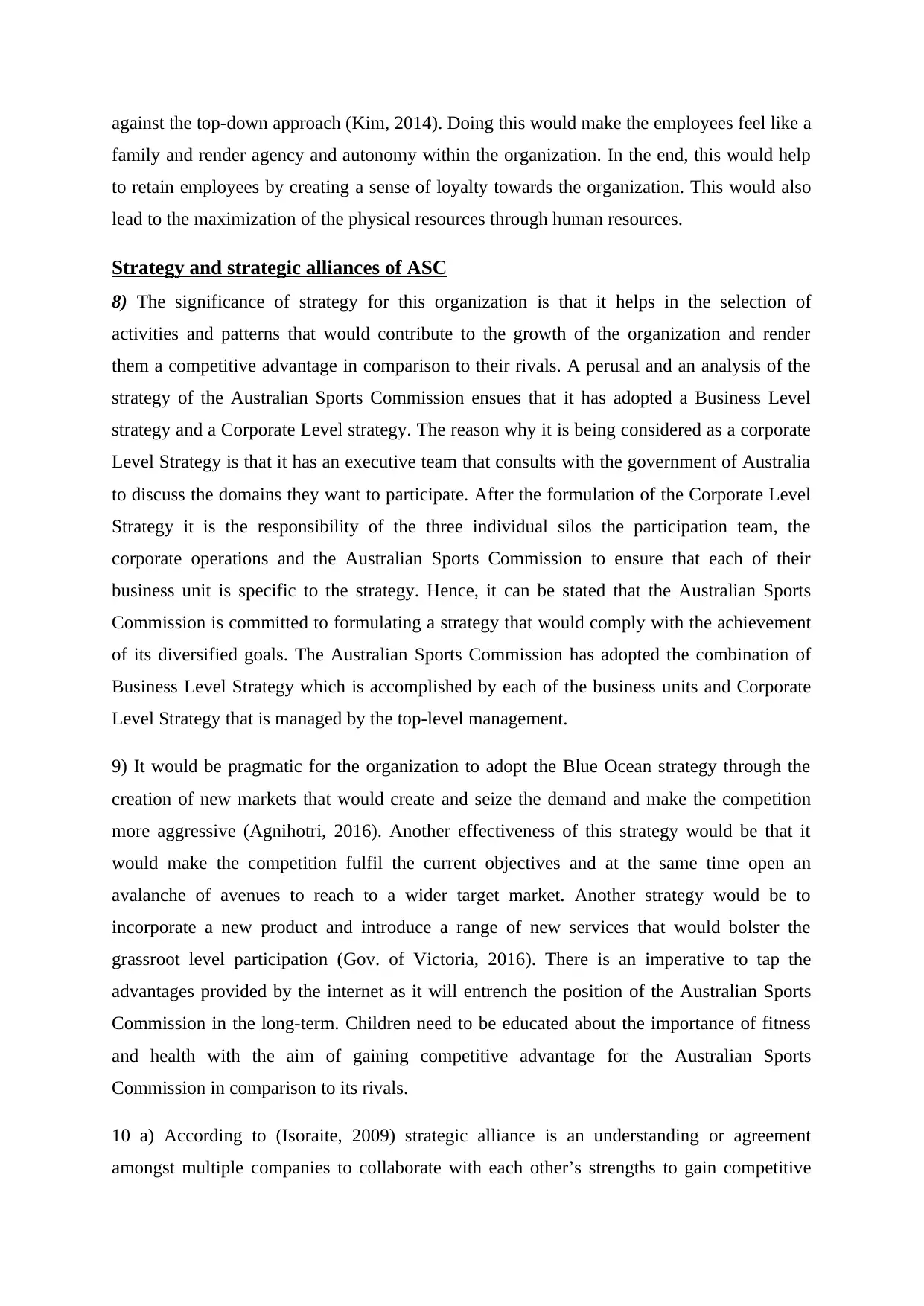
against the top-down approach (Kim, 2014). Doing this would make the employees feel like a
family and render agency and autonomy within the organization. In the end, this would help
to retain employees by creating a sense of loyalty towards the organization. This would also
lead to the maximization of the physical resources through human resources.
Strategy and strategic alliances of ASC
8) The significance of strategy for this organization is that it helps in the selection of
activities and patterns that would contribute to the growth of the organization and render
them a competitive advantage in comparison to their rivals. A perusal and an analysis of the
strategy of the Australian Sports Commission ensues that it has adopted a Business Level
strategy and a Corporate Level strategy. The reason why it is being considered as a corporate
Level Strategy is that it has an executive team that consults with the government of Australia
to discuss the domains they want to participate. After the formulation of the Corporate Level
Strategy it is the responsibility of the three individual silos the participation team, the
corporate operations and the Australian Sports Commission to ensure that each of their
business unit is specific to the strategy. Hence, it can be stated that the Australian Sports
Commission is committed to formulating a strategy that would comply with the achievement
of its diversified goals. The Australian Sports Commission has adopted the combination of
Business Level Strategy which is accomplished by each of the business units and Corporate
Level Strategy that is managed by the top-level management.
9) It would be pragmatic for the organization to adopt the Blue Ocean strategy through the
creation of new markets that would create and seize the demand and make the competition
more aggressive (Agnihotri, 2016). Another effectiveness of this strategy would be that it
would make the competition fulfil the current objectives and at the same time open an
avalanche of avenues to reach to a wider target market. Another strategy would be to
incorporate a new product and introduce a range of new services that would bolster the
grassroot level participation (Gov. of Victoria, 2016). There is an imperative to tap the
advantages provided by the internet as it will entrench the position of the Australian Sports
Commission in the long-term. Children need to be educated about the importance of fitness
and health with the aim of gaining competitive advantage for the Australian Sports
Commission in comparison to its rivals.
10 a) According to (Isoraite, 2009) strategic alliance is an understanding or agreement
amongst multiple companies to collaborate with each other’s strengths to gain competitive
family and render agency and autonomy within the organization. In the end, this would help
to retain employees by creating a sense of loyalty towards the organization. This would also
lead to the maximization of the physical resources through human resources.
Strategy and strategic alliances of ASC
8) The significance of strategy for this organization is that it helps in the selection of
activities and patterns that would contribute to the growth of the organization and render
them a competitive advantage in comparison to their rivals. A perusal and an analysis of the
strategy of the Australian Sports Commission ensues that it has adopted a Business Level
strategy and a Corporate Level strategy. The reason why it is being considered as a corporate
Level Strategy is that it has an executive team that consults with the government of Australia
to discuss the domains they want to participate. After the formulation of the Corporate Level
Strategy it is the responsibility of the three individual silos the participation team, the
corporate operations and the Australian Sports Commission to ensure that each of their
business unit is specific to the strategy. Hence, it can be stated that the Australian Sports
Commission is committed to formulating a strategy that would comply with the achievement
of its diversified goals. The Australian Sports Commission has adopted the combination of
Business Level Strategy which is accomplished by each of the business units and Corporate
Level Strategy that is managed by the top-level management.
9) It would be pragmatic for the organization to adopt the Blue Ocean strategy through the
creation of new markets that would create and seize the demand and make the competition
more aggressive (Agnihotri, 2016). Another effectiveness of this strategy would be that it
would make the competition fulfil the current objectives and at the same time open an
avalanche of avenues to reach to a wider target market. Another strategy would be to
incorporate a new product and introduce a range of new services that would bolster the
grassroot level participation (Gov. of Victoria, 2016). There is an imperative to tap the
advantages provided by the internet as it will entrench the position of the Australian Sports
Commission in the long-term. Children need to be educated about the importance of fitness
and health with the aim of gaining competitive advantage for the Australian Sports
Commission in comparison to its rivals.
10 a) According to (Isoraite, 2009) strategic alliance is an understanding or agreement
amongst multiple companies to collaborate with each other’s strengths to gain competitive
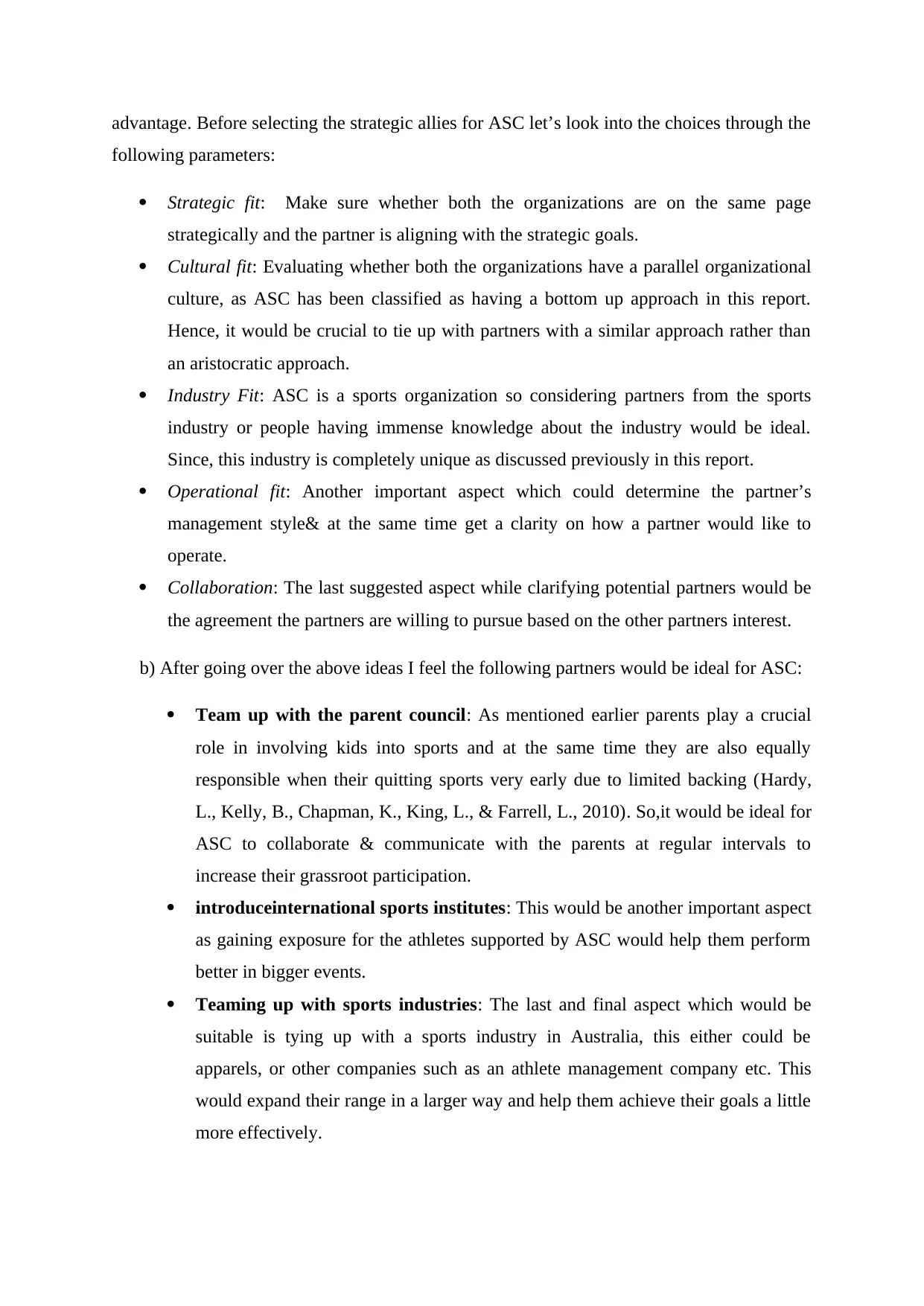
advantage. Before selecting the strategic allies for ASC let’s look into the choices through the
following parameters:
Strategic fit: Make sure whether both the organizations are on the same page
strategically and the partner is aligning with the strategic goals.
Cultural fit: Evaluating whether both the organizations have a parallel organizational
culture, as ASC has been classified as having a bottom up approach in this report.
Hence, it would be crucial to tie up with partners with a similar approach rather than
an aristocratic approach.
Industry Fit: ASC is a sports organization so considering partners from the sports
industry or people having immense knowledge about the industry would be ideal.
Since, this industry is completely unique as discussed previously in this report.
Operational fit: Another important aspect which could determine the partner’s
management style& at the same time get a clarity on how a partner would like to
operate.
Collaboration: The last suggested aspect while clarifying potential partners would be
the agreement the partners are willing to pursue based on the other partners interest.
b) After going over the above ideas I feel the following partners would be ideal for ASC:
Team up with the parent council: As mentioned earlier parents play a crucial
role in involving kids into sports and at the same time they are also equally
responsible when their quitting sports very early due to limited backing (Hardy,
L., Kelly, B., Chapman, K., King, L., & Farrell, L., 2010). So,it would be ideal for
ASC to collaborate & communicate with the parents at regular intervals to
increase their grassroot participation.
introduceinternational sports institutes: This would be another important aspect
as gaining exposure for the athletes supported by ASC would help them perform
better in bigger events.
Teaming up with sports industries: The last and final aspect which would be
suitable is tying up with a sports industry in Australia, this either could be
apparels, or other companies such as an athlete management company etc. This
would expand their range in a larger way and help them achieve their goals a little
more effectively.
following parameters:
Strategic fit: Make sure whether both the organizations are on the same page
strategically and the partner is aligning with the strategic goals.
Cultural fit: Evaluating whether both the organizations have a parallel organizational
culture, as ASC has been classified as having a bottom up approach in this report.
Hence, it would be crucial to tie up with partners with a similar approach rather than
an aristocratic approach.
Industry Fit: ASC is a sports organization so considering partners from the sports
industry or people having immense knowledge about the industry would be ideal.
Since, this industry is completely unique as discussed previously in this report.
Operational fit: Another important aspect which could determine the partner’s
management style& at the same time get a clarity on how a partner would like to
operate.
Collaboration: The last suggested aspect while clarifying potential partners would be
the agreement the partners are willing to pursue based on the other partners interest.
b) After going over the above ideas I feel the following partners would be ideal for ASC:
Team up with the parent council: As mentioned earlier parents play a crucial
role in involving kids into sports and at the same time they are also equally
responsible when their quitting sports very early due to limited backing (Hardy,
L., Kelly, B., Chapman, K., King, L., & Farrell, L., 2010). So,it would be ideal for
ASC to collaborate & communicate with the parents at regular intervals to
increase their grassroot participation.
introduceinternational sports institutes: This would be another important aspect
as gaining exposure for the athletes supported by ASC would help them perform
better in bigger events.
Teaming up with sports industries: The last and final aspect which would be
suitable is tying up with a sports industry in Australia, this either could be
apparels, or other companies such as an athlete management company etc. This
would expand their range in a larger way and help them achieve their goals a little
more effectively.
Paraphrase This Document
Need a fresh take? Get an instant paraphrase of this document with our AI Paraphraser
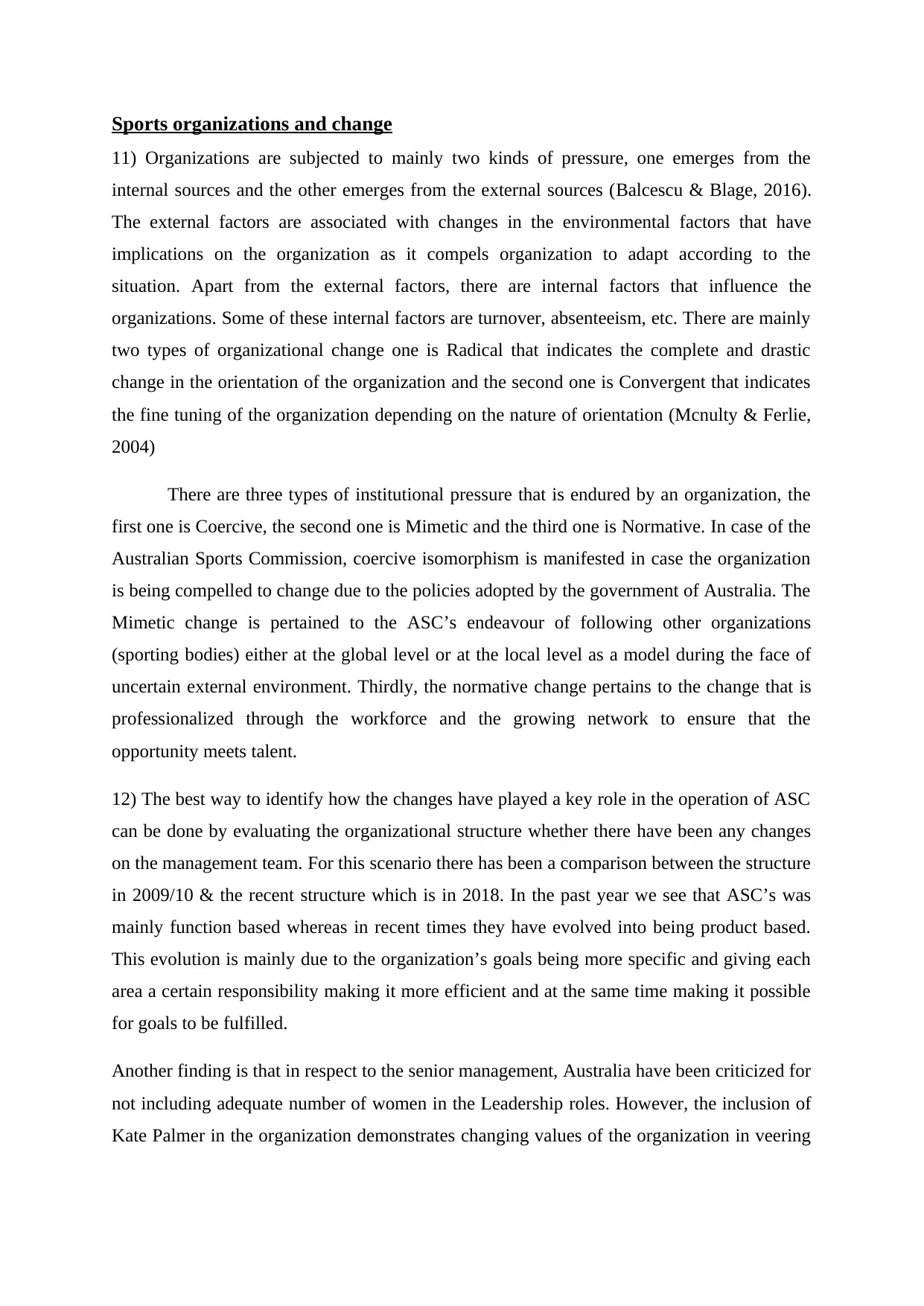
Sports organizations and change
11) Organizations are subjected to mainly two kinds of pressure, one emerges from the
internal sources and the other emerges from the external sources (Balcescu & Blage, 2016).
The external factors are associated with changes in the environmental factors that have
implications on the organization as it compels organization to adapt according to the
situation. Apart from the external factors, there are internal factors that influence the
organizations. Some of these internal factors are turnover, absenteeism, etc. There are mainly
two types of organizational change one is Radical that indicates the complete and drastic
change in the orientation of the organization and the second one is Convergent that indicates
the fine tuning of the organization depending on the nature of orientation (Mcnulty & Ferlie,
2004)
There are three types of institutional pressure that is endured by an organization, the
first one is Coercive, the second one is Mimetic and the third one is Normative. In case of the
Australian Sports Commission, coercive isomorphism is manifested in case the organization
is being compelled to change due to the policies adopted by the government of Australia. The
Mimetic change is pertained to the ASC’s endeavour of following other organizations
(sporting bodies) either at the global level or at the local level as a model during the face of
uncertain external environment. Thirdly, the normative change pertains to the change that is
professionalized through the workforce and the growing network to ensure that the
opportunity meets talent.
12) The best way to identify how the changes have played a key role in the operation of ASC
can be done by evaluating the organizational structure whether there have been any changes
on the management team. For this scenario there has been a comparison between the structure
in 2009/10 & the recent structure which is in 2018. In the past year we see that ASC’s was
mainly function based whereas in recent times they have evolved into being product based.
This evolution is mainly due to the organization’s goals being more specific and giving each
area a certain responsibility making it more efficient and at the same time making it possible
for goals to be fulfilled.
Another finding is that in respect to the senior management, Australia have been criticized for
not including adequate number of women in the Leadership roles. However, the inclusion of
Kate Palmer in the organization demonstrates changing values of the organization in veering
11) Organizations are subjected to mainly two kinds of pressure, one emerges from the
internal sources and the other emerges from the external sources (Balcescu & Blage, 2016).
The external factors are associated with changes in the environmental factors that have
implications on the organization as it compels organization to adapt according to the
situation. Apart from the external factors, there are internal factors that influence the
organizations. Some of these internal factors are turnover, absenteeism, etc. There are mainly
two types of organizational change one is Radical that indicates the complete and drastic
change in the orientation of the organization and the second one is Convergent that indicates
the fine tuning of the organization depending on the nature of orientation (Mcnulty & Ferlie,
2004)
There are three types of institutional pressure that is endured by an organization, the
first one is Coercive, the second one is Mimetic and the third one is Normative. In case of the
Australian Sports Commission, coercive isomorphism is manifested in case the organization
is being compelled to change due to the policies adopted by the government of Australia. The
Mimetic change is pertained to the ASC’s endeavour of following other organizations
(sporting bodies) either at the global level or at the local level as a model during the face of
uncertain external environment. Thirdly, the normative change pertains to the change that is
professionalized through the workforce and the growing network to ensure that the
opportunity meets talent.
12) The best way to identify how the changes have played a key role in the operation of ASC
can be done by evaluating the organizational structure whether there have been any changes
on the management team. For this scenario there has been a comparison between the structure
in 2009/10 & the recent structure which is in 2018. In the past year we see that ASC’s was
mainly function based whereas in recent times they have evolved into being product based.
This evolution is mainly due to the organization’s goals being more specific and giving each
area a certain responsibility making it more efficient and at the same time making it possible
for goals to be fulfilled.
Another finding is that in respect to the senior management, Australia have been criticized for
not including adequate number of women in the Leadership roles. However, the inclusion of
Kate Palmer in the organization demonstrates changing values of the organization in veering
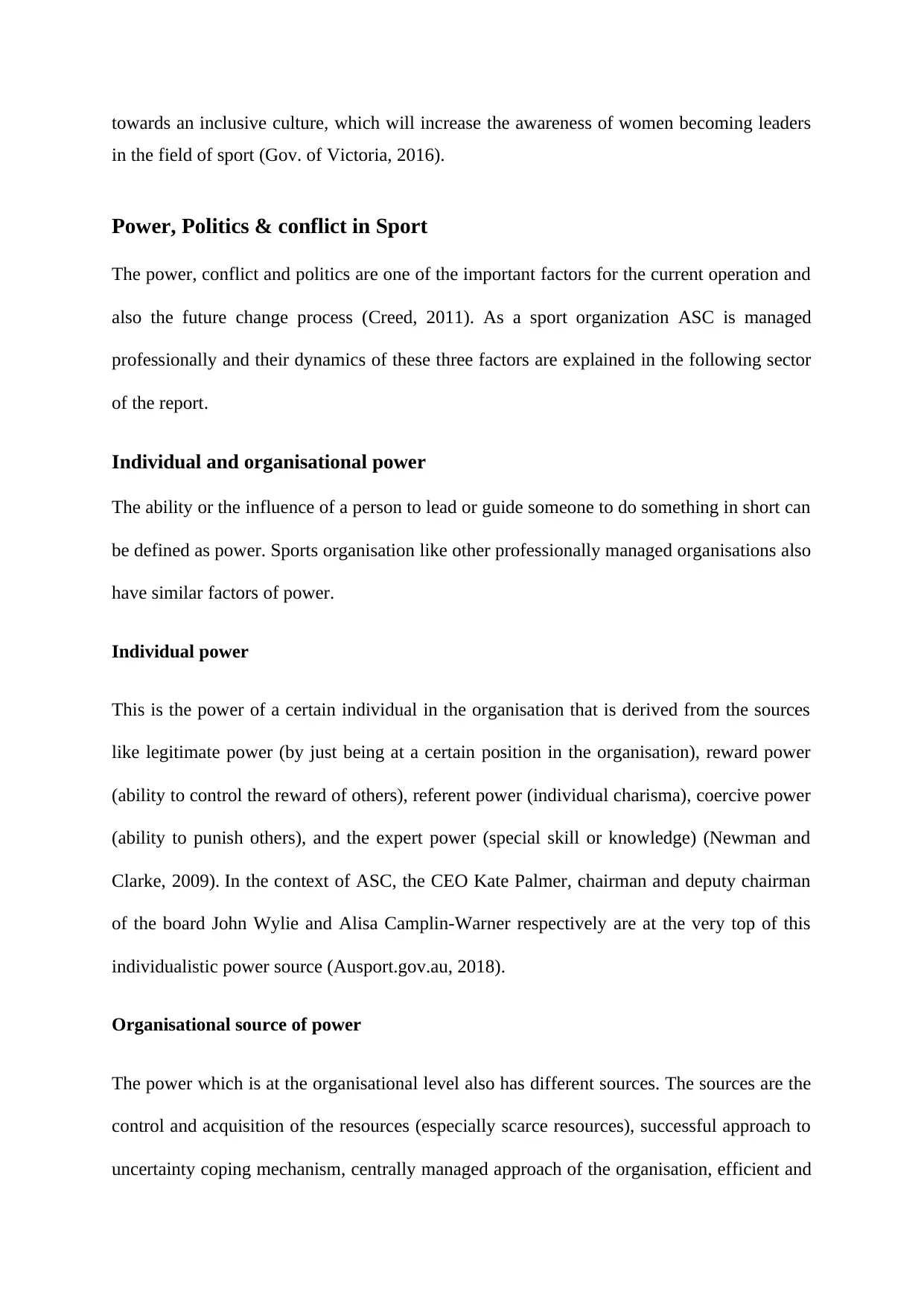
towards an inclusive culture, which will increase the awareness of women becoming leaders
in the field of sport (Gov. of Victoria, 2016).
Power, Politics & conflict in Sport
The power, conflict and politics are one of the important factors for the current operation and
also the future change process (Creed, 2011). As a sport organization ASC is managed
professionally and their dynamics of these three factors are explained in the following sector
of the report.
Individual and organisational power
The ability or the influence of a person to lead or guide someone to do something in short can
be defined as power. Sports organisation like other professionally managed organisations also
have similar factors of power.
Individual power
This is the power of a certain individual in the organisation that is derived from the sources
like legitimate power (by just being at a certain position in the organisation), reward power
(ability to control the reward of others), referent power (individual charisma), coercive power
(ability to punish others), and the expert power (special skill or knowledge) (Newman and
Clarke, 2009). In the context of ASC, the CEO Kate Palmer, chairman and deputy chairman
of the board John Wylie and Alisa Camplin-Warner respectively are at the very top of this
individualistic power source (Ausport.gov.au, 2018).
Organisational source of power
The power which is at the organisational level also has different sources. The sources are the
control and acquisition of the resources (especially scarce resources), successful approach to
uncertainty coping mechanism, centrally managed approach of the organisation, efficient and
in the field of sport (Gov. of Victoria, 2016).
Power, Politics & conflict in Sport
The power, conflict and politics are one of the important factors for the current operation and
also the future change process (Creed, 2011). As a sport organization ASC is managed
professionally and their dynamics of these three factors are explained in the following sector
of the report.
Individual and organisational power
The ability or the influence of a person to lead or guide someone to do something in short can
be defined as power. Sports organisation like other professionally managed organisations also
have similar factors of power.
Individual power
This is the power of a certain individual in the organisation that is derived from the sources
like legitimate power (by just being at a certain position in the organisation), reward power
(ability to control the reward of others), referent power (individual charisma), coercive power
(ability to punish others), and the expert power (special skill or knowledge) (Newman and
Clarke, 2009). In the context of ASC, the CEO Kate Palmer, chairman and deputy chairman
of the board John Wylie and Alisa Camplin-Warner respectively are at the very top of this
individualistic power source (Ausport.gov.au, 2018).
Organisational source of power
The power which is at the organisational level also has different sources. The sources are the
control and acquisition of the resources (especially scarce resources), successful approach to
uncertainty coping mechanism, centrally managed approach of the organisation, efficient and
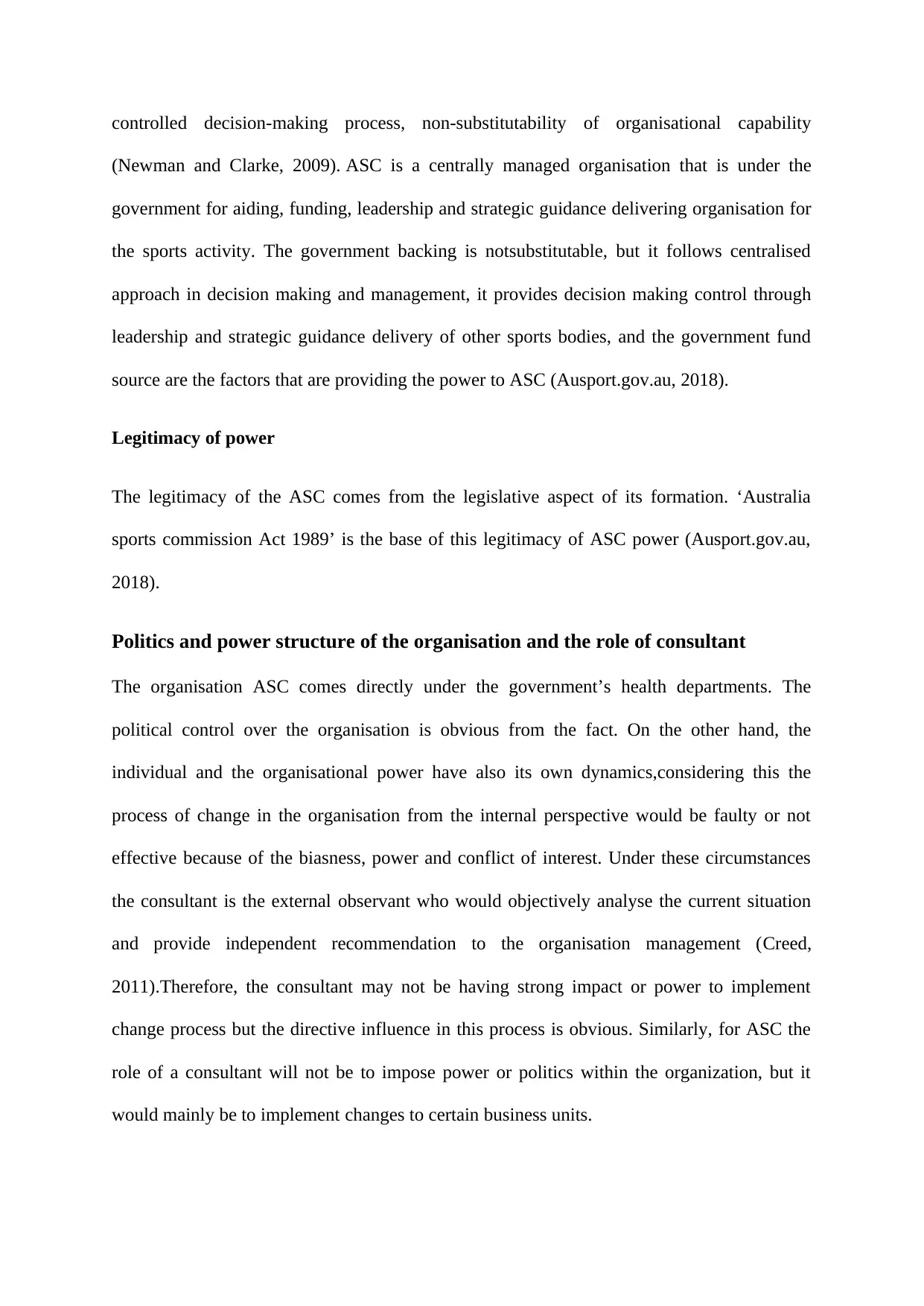
controlled decision-making process, non-substitutability of organisational capability
(Newman and Clarke, 2009). ASC is a centrally managed organisation that is under the
government for aiding, funding, leadership and strategic guidance delivering organisation for
the sports activity. The government backing is notsubstitutable, but it follows centralised
approach in decision making and management, it provides decision making control through
leadership and strategic guidance delivery of other sports bodies, and the government fund
source are the factors that are providing the power to ASC (Ausport.gov.au, 2018).
Legitimacy of power
The legitimacy of the ASC comes from the legislative aspect of its formation. ‘Australia
sports commission Act 1989’ is the base of this legitimacy of ASC power (Ausport.gov.au,
2018).
Politics and power structure of the organisation and the role of consultant
The organisation ASC comes directly under the government’s health departments. The
political control over the organisation is obvious from the fact. On the other hand, the
individual and the organisational power have also its own dynamics,considering this the
process of change in the organisation from the internal perspective would be faulty or not
effective because of the biasness, power and conflict of interest. Under these circumstances
the consultant is the external observant who would objectively analyse the current situation
and provide independent recommendation to the organisation management (Creed,
2011).Therefore, the consultant may not be having strong impact or power to implement
change process but the directive influence in this process is obvious. Similarly, for ASC the
role of a consultant will not be to impose power or politics within the organization, but it
would mainly be to implement changes to certain business units.
(Newman and Clarke, 2009). ASC is a centrally managed organisation that is under the
government for aiding, funding, leadership and strategic guidance delivering organisation for
the sports activity. The government backing is notsubstitutable, but it follows centralised
approach in decision making and management, it provides decision making control through
leadership and strategic guidance delivery of other sports bodies, and the government fund
source are the factors that are providing the power to ASC (Ausport.gov.au, 2018).
Legitimacy of power
The legitimacy of the ASC comes from the legislative aspect of its formation. ‘Australia
sports commission Act 1989’ is the base of this legitimacy of ASC power (Ausport.gov.au,
2018).
Politics and power structure of the organisation and the role of consultant
The organisation ASC comes directly under the government’s health departments. The
political control over the organisation is obvious from the fact. On the other hand, the
individual and the organisational power have also its own dynamics,considering this the
process of change in the organisation from the internal perspective would be faulty or not
effective because of the biasness, power and conflict of interest. Under these circumstances
the consultant is the external observant who would objectively analyse the current situation
and provide independent recommendation to the organisation management (Creed,
2011).Therefore, the consultant may not be having strong impact or power to implement
change process but the directive influence in this process is obvious. Similarly, for ASC the
role of a consultant will not be to impose power or politics within the organization, but it
would mainly be to implement changes to certain business units.
Secure Best Marks with AI Grader
Need help grading? Try our AI Grader for instant feedback on your assignments.
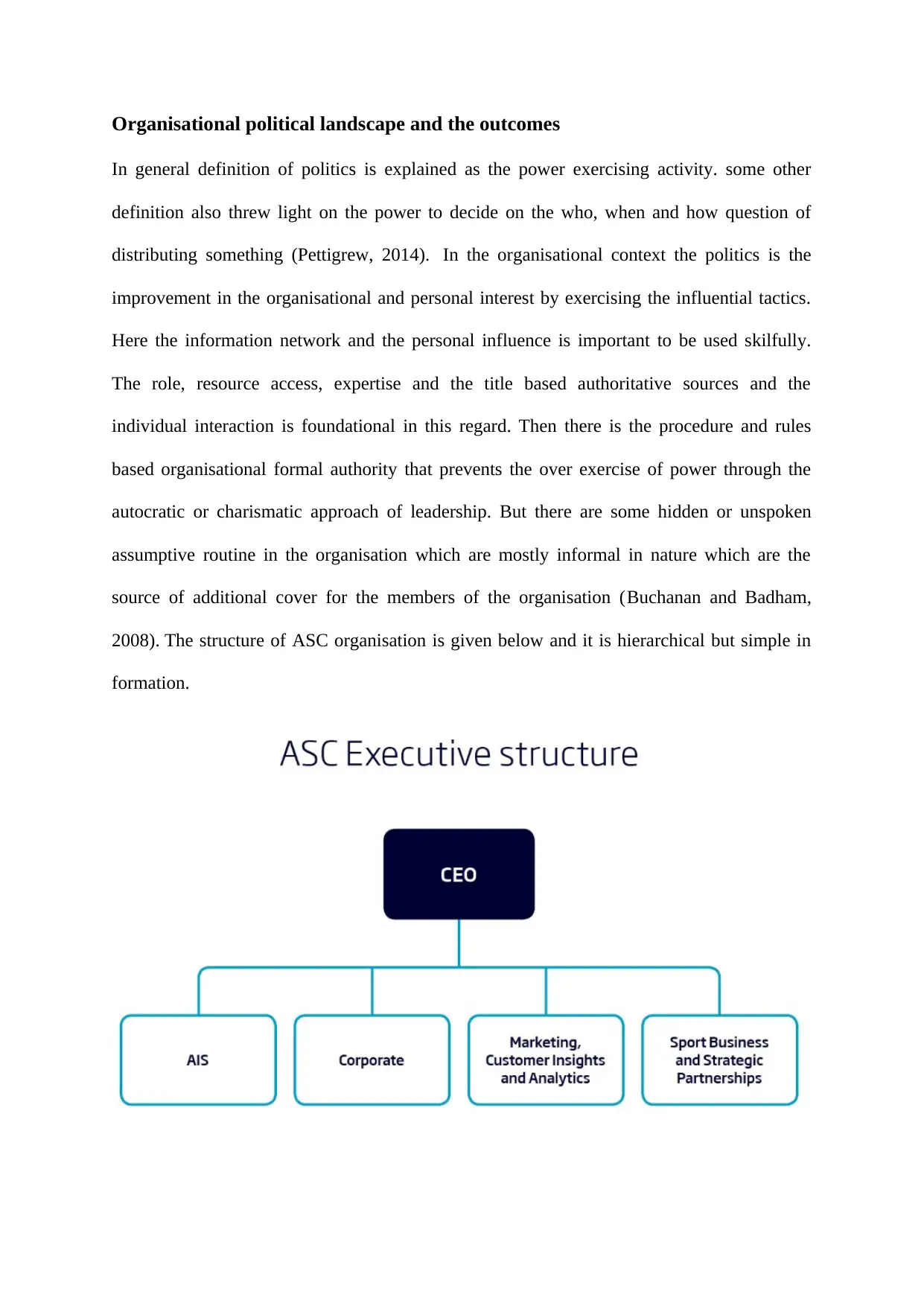
Organisational political landscape and the outcomes
In general definition of politics is explained as the power exercising activity. some other
definition also threw light on the power to decide on the who, when and how question of
distributing something (Pettigrew, 2014). In the organisational context the politics is the
improvement in the organisational and personal interest by exercising the influential tactics.
Here the information network and the personal influence is important to be used skilfully.
The role, resource access, expertise and the title based authoritative sources and the
individual interaction is foundational in this regard. Then there is the procedure and rules
based organisational formal authority that prevents the over exercise of power through the
autocratic or charismatic approach of leadership. But there are some hidden or unspoken
assumptive routine in the organisation which are mostly informal in nature which are the
source of additional cover for the members of the organisation (Buchanan and Badham,
2008). The structure of ASC organisation is given below and it is hierarchical but simple in
formation.
In general definition of politics is explained as the power exercising activity. some other
definition also threw light on the power to decide on the who, when and how question of
distributing something (Pettigrew, 2014). In the organisational context the politics is the
improvement in the organisational and personal interest by exercising the influential tactics.
Here the information network and the personal influence is important to be used skilfully.
The role, resource access, expertise and the title based authoritative sources and the
individual interaction is foundational in this regard. Then there is the procedure and rules
based organisational formal authority that prevents the over exercise of power through the
autocratic or charismatic approach of leadership. But there are some hidden or unspoken
assumptive routine in the organisation which are mostly informal in nature which are the
source of additional cover for the members of the organisation (Buchanan and Badham,
2008). The structure of ASC organisation is given below and it is hierarchical but simple in
formation.
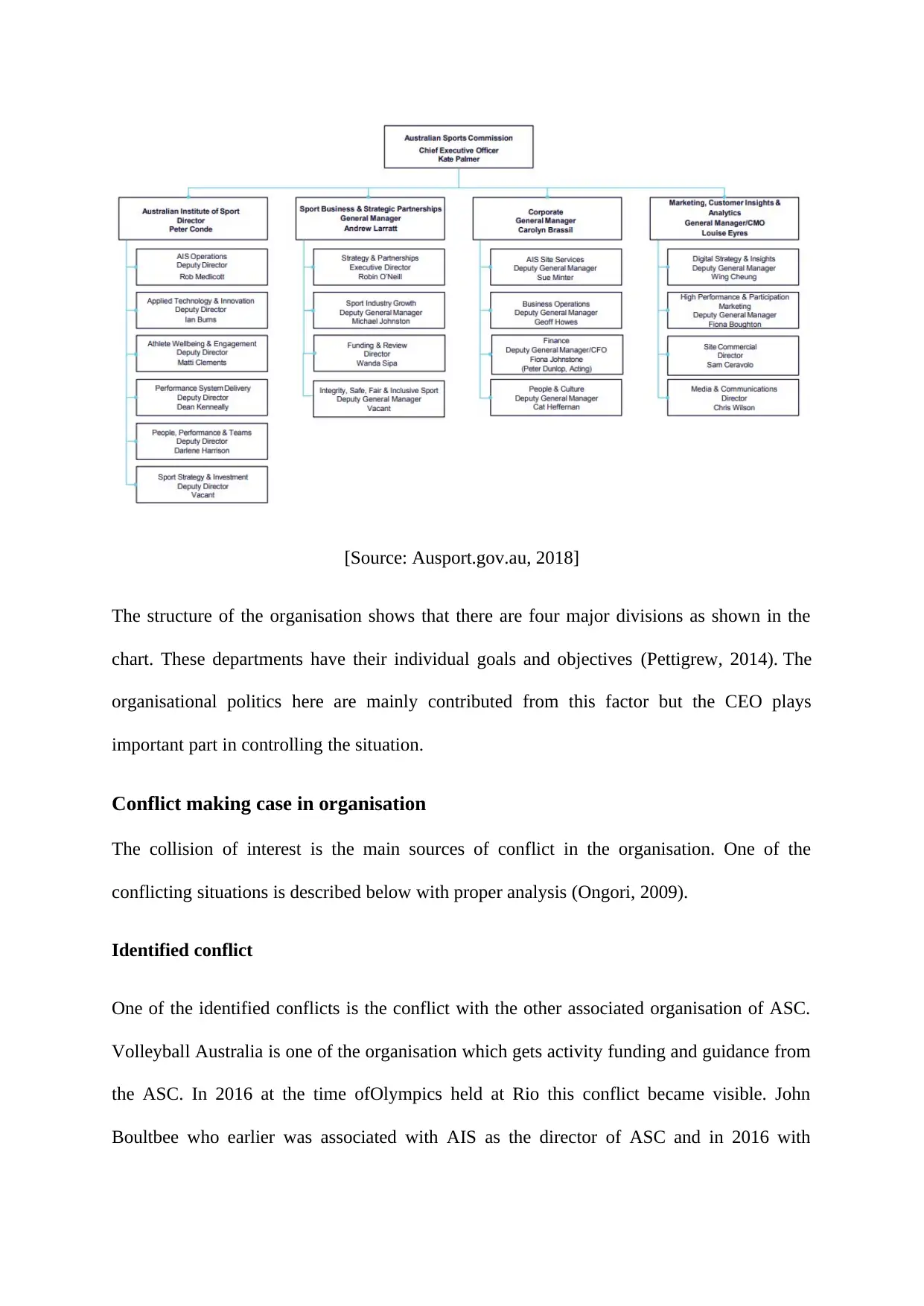
[Source: Ausport.gov.au, 2018]
The structure of the organisation shows that there are four major divisions as shown in the
chart. These departments have their individual goals and objectives (Pettigrew, 2014). The
organisational politics here are mainly contributed from this factor but the CEO plays
important part in controlling the situation.
Conflict making case in organisation
The collision of interest is the main sources of conflict in the organisation. One of the
conflicting situations is described below with proper analysis (Ongori, 2009).
Identified conflict
One of the identified conflicts is the conflict with the other associated organisation of ASC.
Volleyball Australia is one of the organisation which gets activity funding and guidance from
the ASC. In 2016 at the time ofOlympics held at Rio this conflict became visible. John
Boultbee who earlier was associated with AIS as the director of ASC and in 2016 with
The structure of the organisation shows that there are four major divisions as shown in the
chart. These departments have their individual goals and objectives (Pettigrew, 2014). The
organisational politics here are mainly contributed from this factor but the CEO plays
important part in controlling the situation.
Conflict making case in organisation
The collision of interest is the main sources of conflict in the organisation. One of the
conflicting situations is described below with proper analysis (Ongori, 2009).
Identified conflict
One of the identified conflicts is the conflict with the other associated organisation of ASC.
Volleyball Australia is one of the organisation which gets activity funding and guidance from
the ASC. In 2016 at the time ofOlympics held at Rio this conflict became visible. John
Boultbee who earlier was associated with AIS as the director of ASC and in 2016 with
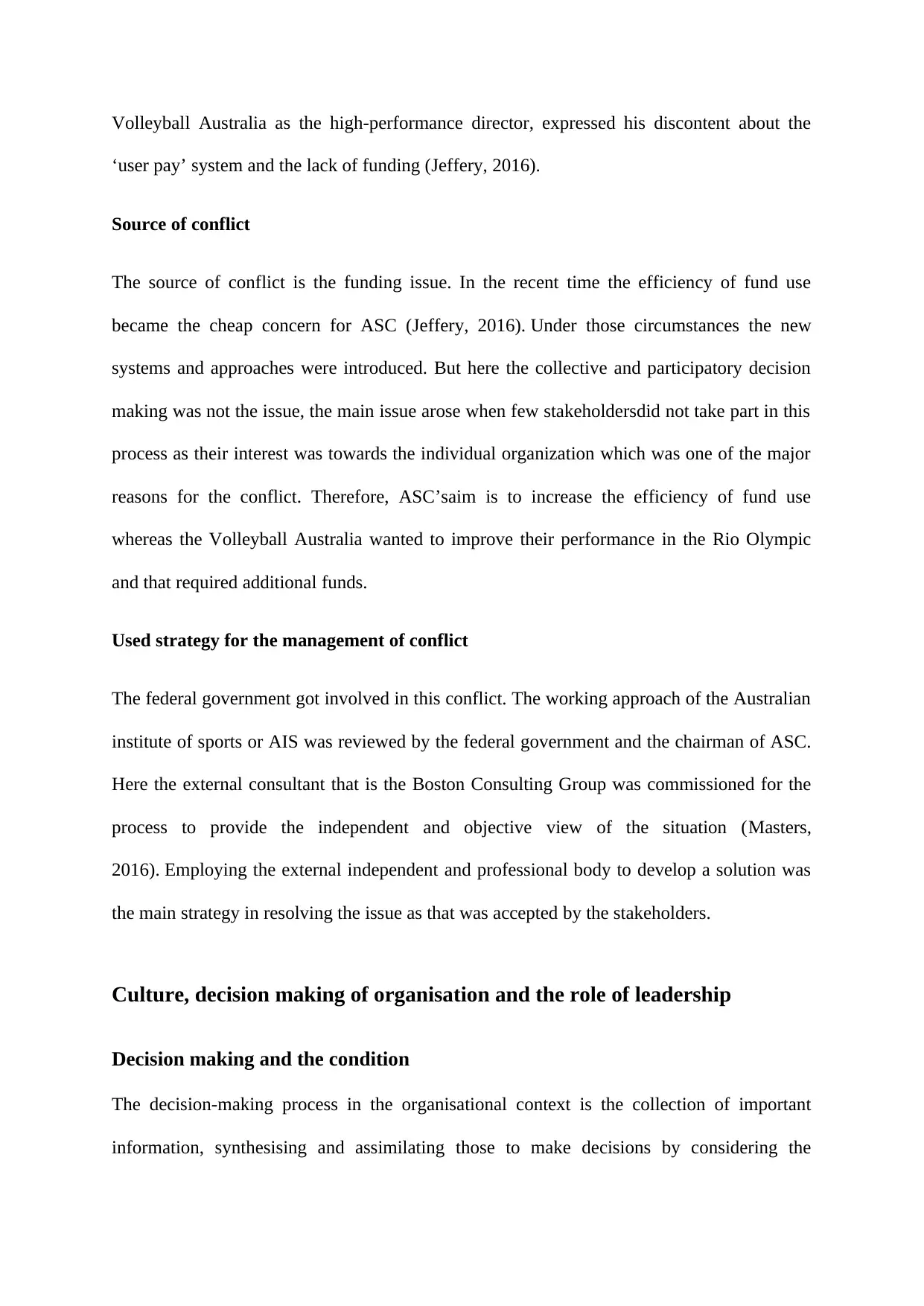
Volleyball Australia as the high-performance director, expressed his discontent about the
‘user pay’ system and the lack of funding (Jeffery, 2016).
Source of conflict
The source of conflict is the funding issue. In the recent time the efficiency of fund use
became the cheap concern for ASC (Jeffery, 2016). Under those circumstances the new
systems and approaches were introduced. But here the collective and participatory decision
making was not the issue, the main issue arose when few stakeholdersdid not take part in this
process as their interest was towards the individual organization which was one of the major
reasons for the conflict. Therefore, ASC’saim is to increase the efficiency of fund use
whereas the Volleyball Australia wanted to improve their performance in the Rio Olympic
and that required additional funds.
Used strategy for the management of conflict
The federal government got involved in this conflict. The working approach of the Australian
institute of sports or AIS was reviewed by the federal government and the chairman of ASC.
Here the external consultant that is the Boston Consulting Group was commissioned for the
process to provide the independent and objective view of the situation (Masters,
2016). Employing the external independent and professional body to develop a solution was
the main strategy in resolving the issue as that was accepted by the stakeholders.
Culture, decision making of organisation and the role of leadership
Decision making and the condition
The decision-making process in the organisational context is the collection of important
information, synthesising and assimilating those to make decisions by considering the
‘user pay’ system and the lack of funding (Jeffery, 2016).
Source of conflict
The source of conflict is the funding issue. In the recent time the efficiency of fund use
became the cheap concern for ASC (Jeffery, 2016). Under those circumstances the new
systems and approaches were introduced. But here the collective and participatory decision
making was not the issue, the main issue arose when few stakeholdersdid not take part in this
process as their interest was towards the individual organization which was one of the major
reasons for the conflict. Therefore, ASC’saim is to increase the efficiency of fund use
whereas the Volleyball Australia wanted to improve their performance in the Rio Olympic
and that required additional funds.
Used strategy for the management of conflict
The federal government got involved in this conflict. The working approach of the Australian
institute of sports or AIS was reviewed by the federal government and the chairman of ASC.
Here the external consultant that is the Boston Consulting Group was commissioned for the
process to provide the independent and objective view of the situation (Masters,
2016). Employing the external independent and professional body to develop a solution was
the main strategy in resolving the issue as that was accepted by the stakeholders.
Culture, decision making of organisation and the role of leadership
Decision making and the condition
The decision-making process in the organisational context is the collection of important
information, synthesising and assimilating those to make decisions by considering the
Paraphrase This Document
Need a fresh take? Get an instant paraphrase of this document with our AI Paraphraser
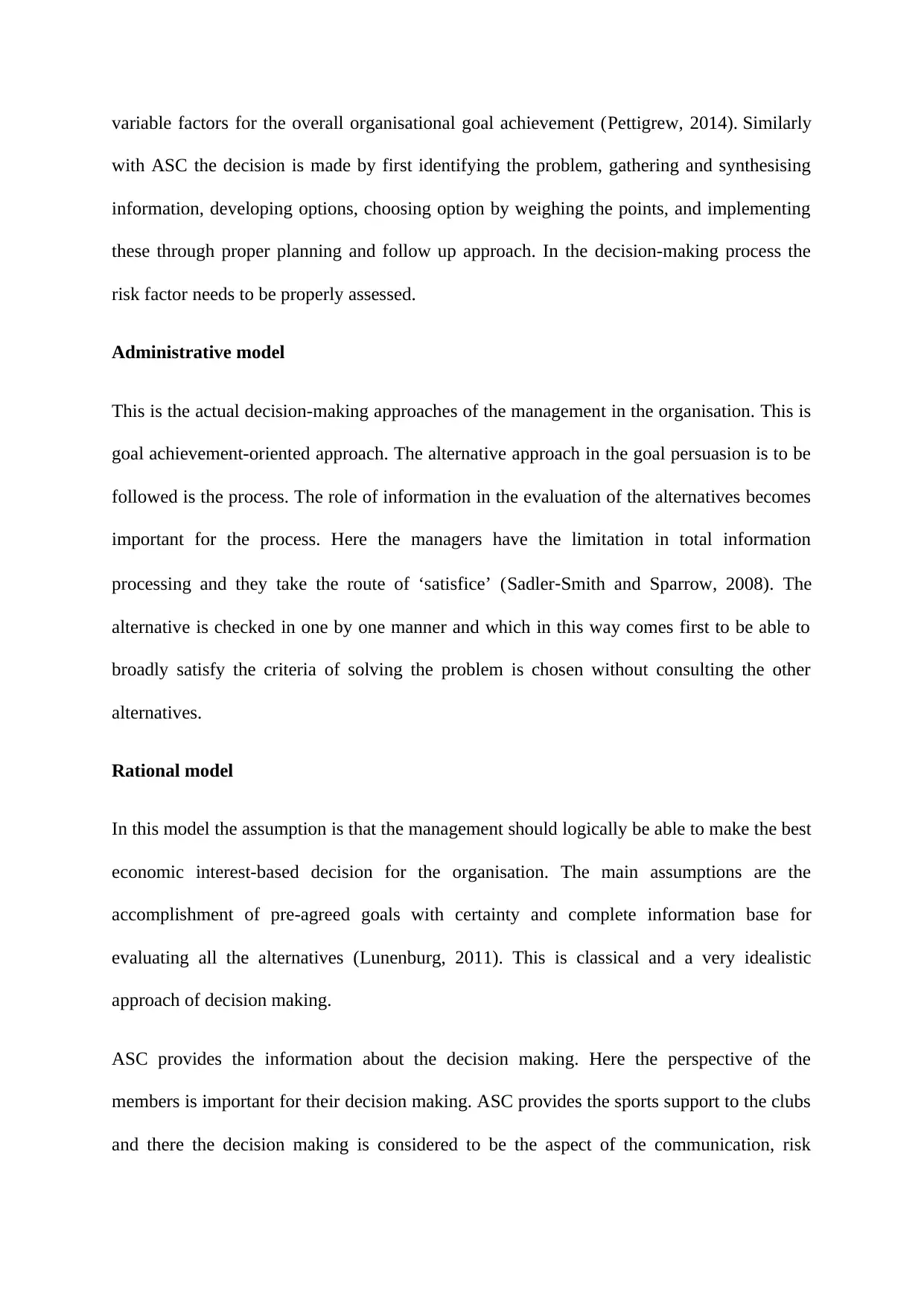
variable factors for the overall organisational goal achievement (Pettigrew, 2014). Similarly
with ASC the decision is made by first identifying the problem, gathering and synthesising
information, developing options, choosing option by weighing the points, and implementing
these through proper planning and follow up approach. In the decision-making process the
risk factor needs to be properly assessed.
Administrative model
This is the actual decision-making approaches of the management in the organisation. This is
goal achievement-oriented approach. The alternative approach in the goal persuasion is to be
followed is the process. The role of information in the evaluation of the alternatives becomes
important for the process. Here the managers have the limitation in total information
processing and they take the route of ‘satisfice’ (Sadler‐Smith and Sparrow, 2008). The
alternative is checked in one by one manner and which in this way comes first to be able to
broadly satisfy the criteria of solving the problem is chosen without consulting the other
alternatives.
Rational model
In this model the assumption is that the management should logically be able to make the best
economic interest-based decision for the organisation. The main assumptions are the
accomplishment of pre-agreed goals with certainty and complete information base for
evaluating all the alternatives (Lunenburg, 2011). This is classical and a very idealistic
approach of decision making.
ASC provides the information about the decision making. Here the perspective of the
members is important for their decision making. ASC provides the sports support to the clubs
and there the decision making is considered to be the aspect of the communication, risk
with ASC the decision is made by first identifying the problem, gathering and synthesising
information, developing options, choosing option by weighing the points, and implementing
these through proper planning and follow up approach. In the decision-making process the
risk factor needs to be properly assessed.
Administrative model
This is the actual decision-making approaches of the management in the organisation. This is
goal achievement-oriented approach. The alternative approach in the goal persuasion is to be
followed is the process. The role of information in the evaluation of the alternatives becomes
important for the process. Here the managers have the limitation in total information
processing and they take the route of ‘satisfice’ (Sadler‐Smith and Sparrow, 2008). The
alternative is checked in one by one manner and which in this way comes first to be able to
broadly satisfy the criteria of solving the problem is chosen without consulting the other
alternatives.
Rational model
In this model the assumption is that the management should logically be able to make the best
economic interest-based decision for the organisation. The main assumptions are the
accomplishment of pre-agreed goals with certainty and complete information base for
evaluating all the alternatives (Lunenburg, 2011). This is classical and a very idealistic
approach of decision making.
ASC provides the information about the decision making. Here the perspective of the
members is important for their decision making. ASC provides the sports support to the clubs
and there the decision making is considered to be the aspect of the communication, risk
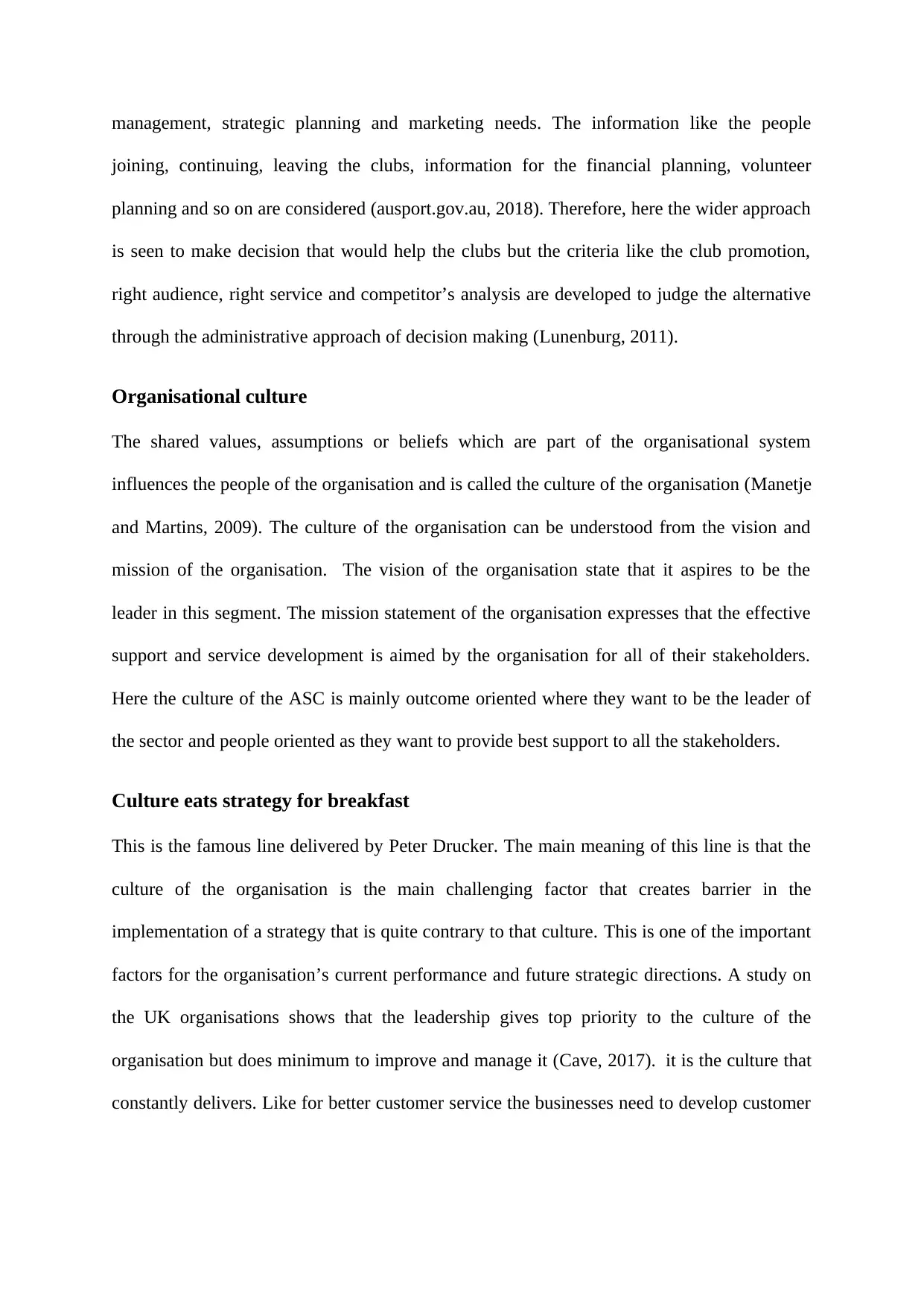
management, strategic planning and marketing needs. The information like the people
joining, continuing, leaving the clubs, information for the financial planning, volunteer
planning and so on are considered (ausport.gov.au, 2018). Therefore, here the wider approach
is seen to make decision that would help the clubs but the criteria like the club promotion,
right audience, right service and competitor’s analysis are developed to judge the alternative
through the administrative approach of decision making (Lunenburg, 2011).
Organisational culture
The shared values, assumptions or beliefs which are part of the organisational system
influences the people of the organisation and is called the culture of the organisation (Manetje
and Martins, 2009). The culture of the organisation can be understood from the vision and
mission of the organisation. The vision of the organisation state that it aspires to be the
leader in this segment. The mission statement of the organisation expresses that the effective
support and service development is aimed by the organisation for all of their stakeholders.
Here the culture of the ASC is mainly outcome oriented where they want to be the leader of
the sector and people oriented as they want to provide best support to all the stakeholders.
Culture eats strategy for breakfast
This is the famous line delivered by Peter Drucker. The main meaning of this line is that the
culture of the organisation is the main challenging factor that creates barrier in the
implementation of a strategy that is quite contrary to that culture. This is one of the important
factors for the organisation’s current performance and future strategic directions. A study on
the UK organisations shows that the leadership gives top priority to the culture of the
organisation but does minimum to improve and manage it (Cave, 2017). it is the culture that
constantly delivers. Like for better customer service the businesses need to develop customer
joining, continuing, leaving the clubs, information for the financial planning, volunteer
planning and so on are considered (ausport.gov.au, 2018). Therefore, here the wider approach
is seen to make decision that would help the clubs but the criteria like the club promotion,
right audience, right service and competitor’s analysis are developed to judge the alternative
through the administrative approach of decision making (Lunenburg, 2011).
Organisational culture
The shared values, assumptions or beliefs which are part of the organisational system
influences the people of the organisation and is called the culture of the organisation (Manetje
and Martins, 2009). The culture of the organisation can be understood from the vision and
mission of the organisation. The vision of the organisation state that it aspires to be the
leader in this segment. The mission statement of the organisation expresses that the effective
support and service development is aimed by the organisation for all of their stakeholders.
Here the culture of the ASC is mainly outcome oriented where they want to be the leader of
the sector and people oriented as they want to provide best support to all the stakeholders.
Culture eats strategy for breakfast
This is the famous line delivered by Peter Drucker. The main meaning of this line is that the
culture of the organisation is the main challenging factor that creates barrier in the
implementation of a strategy that is quite contrary to that culture. This is one of the important
factors for the organisation’s current performance and future strategic directions. A study on
the UK organisations shows that the leadership gives top priority to the culture of the
organisation but does minimum to improve and manage it (Cave, 2017). it is the culture that
constantly delivers. Like for better customer service the businesses need to develop customer
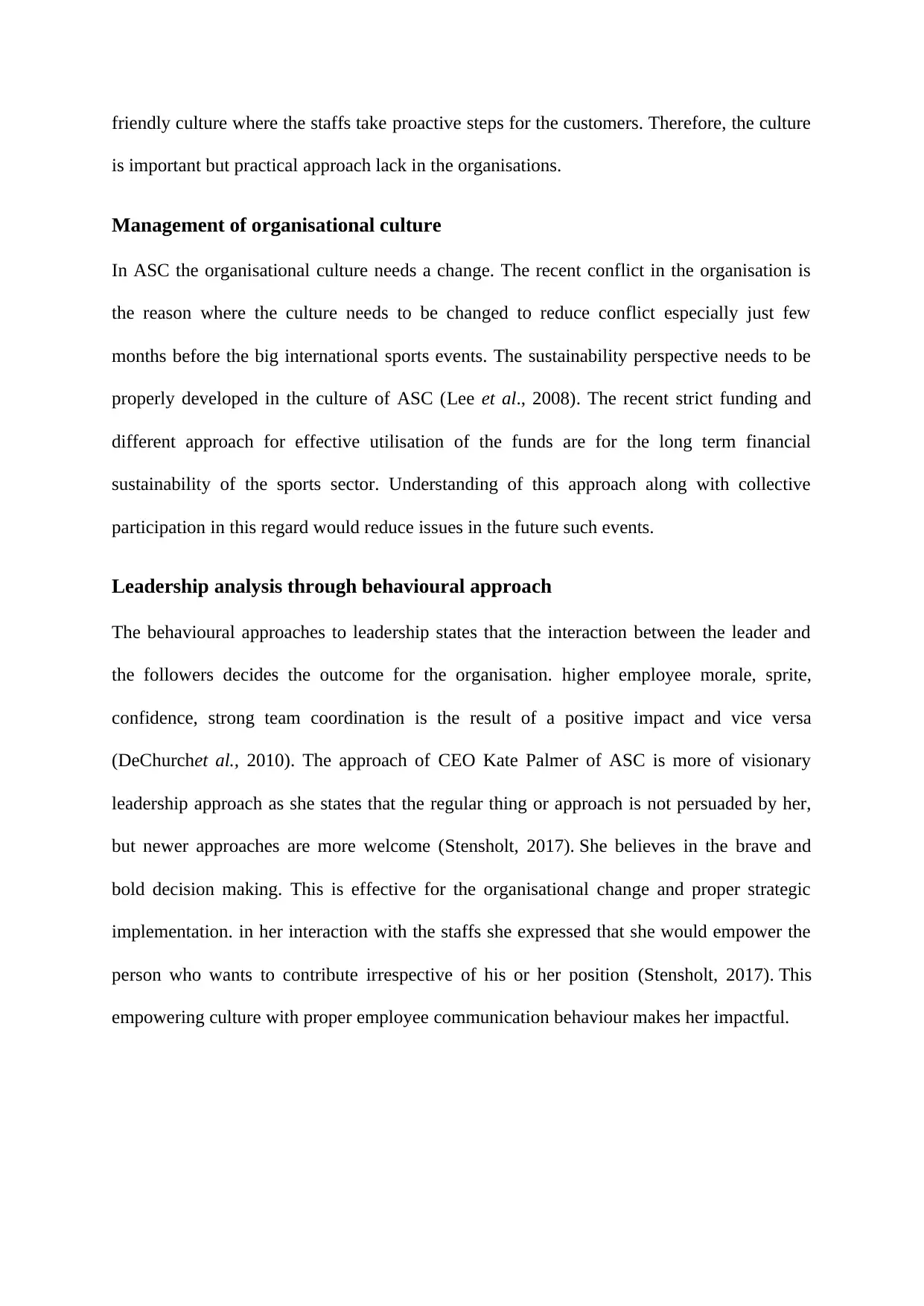
friendly culture where the staffs take proactive steps for the customers. Therefore, the culture
is important but practical approach lack in the organisations.
Management of organisational culture
In ASC the organisational culture needs a change. The recent conflict in the organisation is
the reason where the culture needs to be changed to reduce conflict especially just few
months before the big international sports events. The sustainability perspective needs to be
properly developed in the culture of ASC (Lee et al., 2008). The recent strict funding and
different approach for effective utilisation of the funds are for the long term financial
sustainability of the sports sector. Understanding of this approach along with collective
participation in this regard would reduce issues in the future such events.
Leadership analysis through behavioural approach
The behavioural approaches to leadership states that the interaction between the leader and
the followers decides the outcome for the organisation. higher employee morale, sprite,
confidence, strong team coordination is the result of a positive impact and vice versa
(DeChurchet al., 2010). The approach of CEO Kate Palmer of ASC is more of visionary
leadership approach as she states that the regular thing or approach is not persuaded by her,
but newer approaches are more welcome (Stensholt, 2017). She believes in the brave and
bold decision making. This is effective for the organisational change and proper strategic
implementation. in her interaction with the staffs she expressed that she would empower the
person who wants to contribute irrespective of his or her position (Stensholt, 2017). This
empowering culture with proper employee communication behaviour makes her impactful.
is important but practical approach lack in the organisations.
Management of organisational culture
In ASC the organisational culture needs a change. The recent conflict in the organisation is
the reason where the culture needs to be changed to reduce conflict especially just few
months before the big international sports events. The sustainability perspective needs to be
properly developed in the culture of ASC (Lee et al., 2008). The recent strict funding and
different approach for effective utilisation of the funds are for the long term financial
sustainability of the sports sector. Understanding of this approach along with collective
participation in this regard would reduce issues in the future such events.
Leadership analysis through behavioural approach
The behavioural approaches to leadership states that the interaction between the leader and
the followers decides the outcome for the organisation. higher employee morale, sprite,
confidence, strong team coordination is the result of a positive impact and vice versa
(DeChurchet al., 2010). The approach of CEO Kate Palmer of ASC is more of visionary
leadership approach as she states that the regular thing or approach is not persuaded by her,
but newer approaches are more welcome (Stensholt, 2017). She believes in the brave and
bold decision making. This is effective for the organisational change and proper strategic
implementation. in her interaction with the staffs she expressed that she would empower the
person who wants to contribute irrespective of his or her position (Stensholt, 2017). This
empowering culture with proper employee communication behaviour makes her impactful.
Secure Best Marks with AI Grader
Need help grading? Try our AI Grader for instant feedback on your assignments.
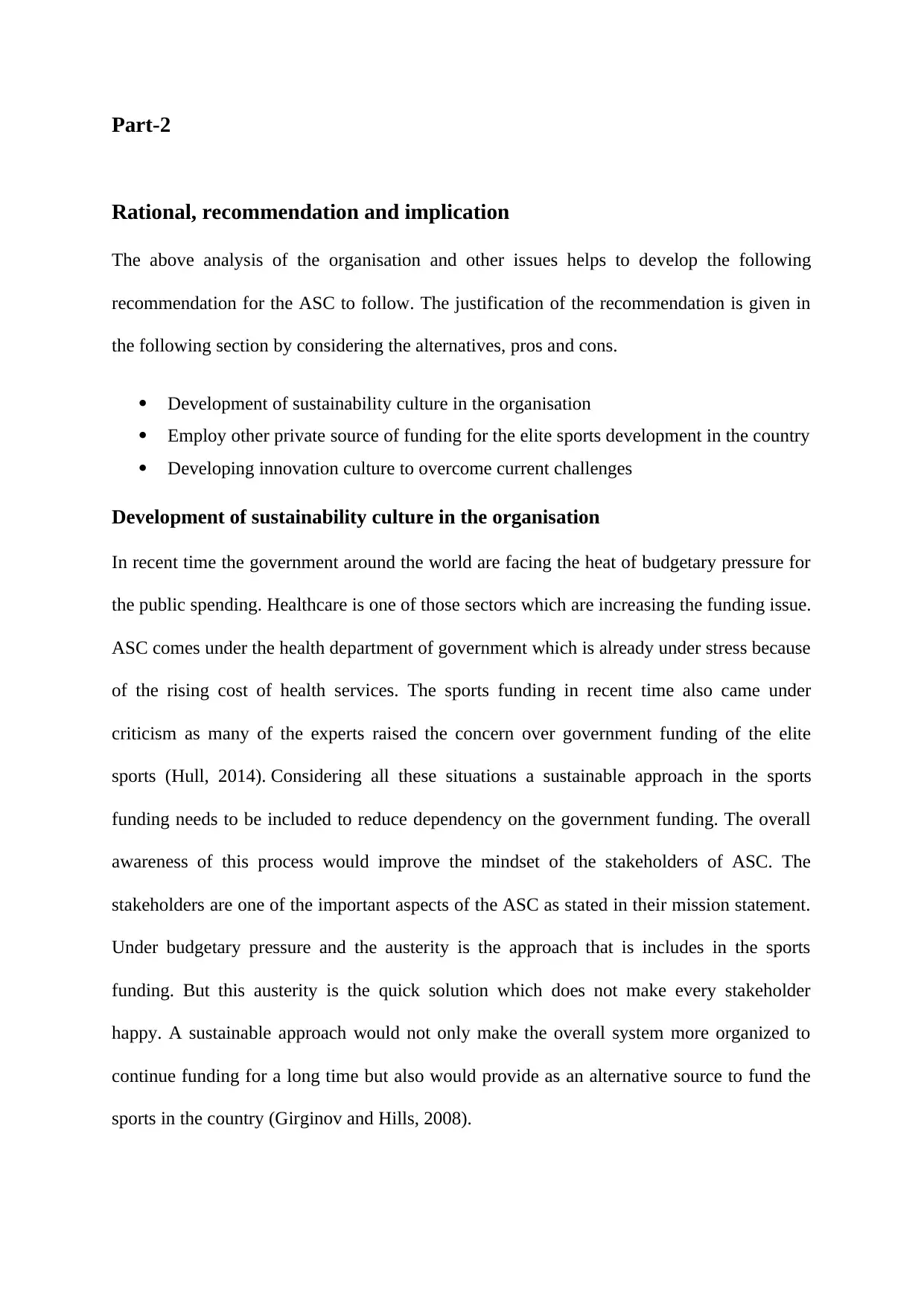
Part-2
Rational, recommendation and implication
The above analysis of the organisation and other issues helps to develop the following
recommendation for the ASC to follow. The justification of the recommendation is given in
the following section by considering the alternatives, pros and cons.
Development of sustainability culture in the organisation
Employ other private source of funding for the elite sports development in the country
Developing innovation culture to overcome current challenges
Development of sustainability culture in the organisation
In recent time the government around the world are facing the heat of budgetary pressure for
the public spending. Healthcare is one of those sectors which are increasing the funding issue.
ASC comes under the health department of government which is already under stress because
of the rising cost of health services. The sports funding in recent time also came under
criticism as many of the experts raised the concern over government funding of the elite
sports (Hull, 2014). Considering all these situations a sustainable approach in the sports
funding needs to be included to reduce dependency on the government funding. The overall
awareness of this process would improve the mindset of the stakeholders of ASC. The
stakeholders are one of the important aspects of the ASC as stated in their mission statement.
Under budgetary pressure and the austerity is the approach that is includes in the sports
funding. But this austerity is the quick solution which does not make every stakeholder
happy. A sustainable approach would not only make the overall system more organized to
continue funding for a long time but also would provide as an alternative source to fund the
sports in the country (Girginov and Hills, 2008).
Rational, recommendation and implication
The above analysis of the organisation and other issues helps to develop the following
recommendation for the ASC to follow. The justification of the recommendation is given in
the following section by considering the alternatives, pros and cons.
Development of sustainability culture in the organisation
Employ other private source of funding for the elite sports development in the country
Developing innovation culture to overcome current challenges
Development of sustainability culture in the organisation
In recent time the government around the world are facing the heat of budgetary pressure for
the public spending. Healthcare is one of those sectors which are increasing the funding issue.
ASC comes under the health department of government which is already under stress because
of the rising cost of health services. The sports funding in recent time also came under
criticism as many of the experts raised the concern over government funding of the elite
sports (Hull, 2014). Considering all these situations a sustainable approach in the sports
funding needs to be included to reduce dependency on the government funding. The overall
awareness of this process would improve the mindset of the stakeholders of ASC. The
stakeholders are one of the important aspects of the ASC as stated in their mission statement.
Under budgetary pressure and the austerity is the approach that is includes in the sports
funding. But this austerity is the quick solution which does not make every stakeholder
happy. A sustainable approach would not only make the overall system more organized to
continue funding for a long time but also would provide as an alternative source to fund the
sports in the country (Girginov and Hills, 2008).
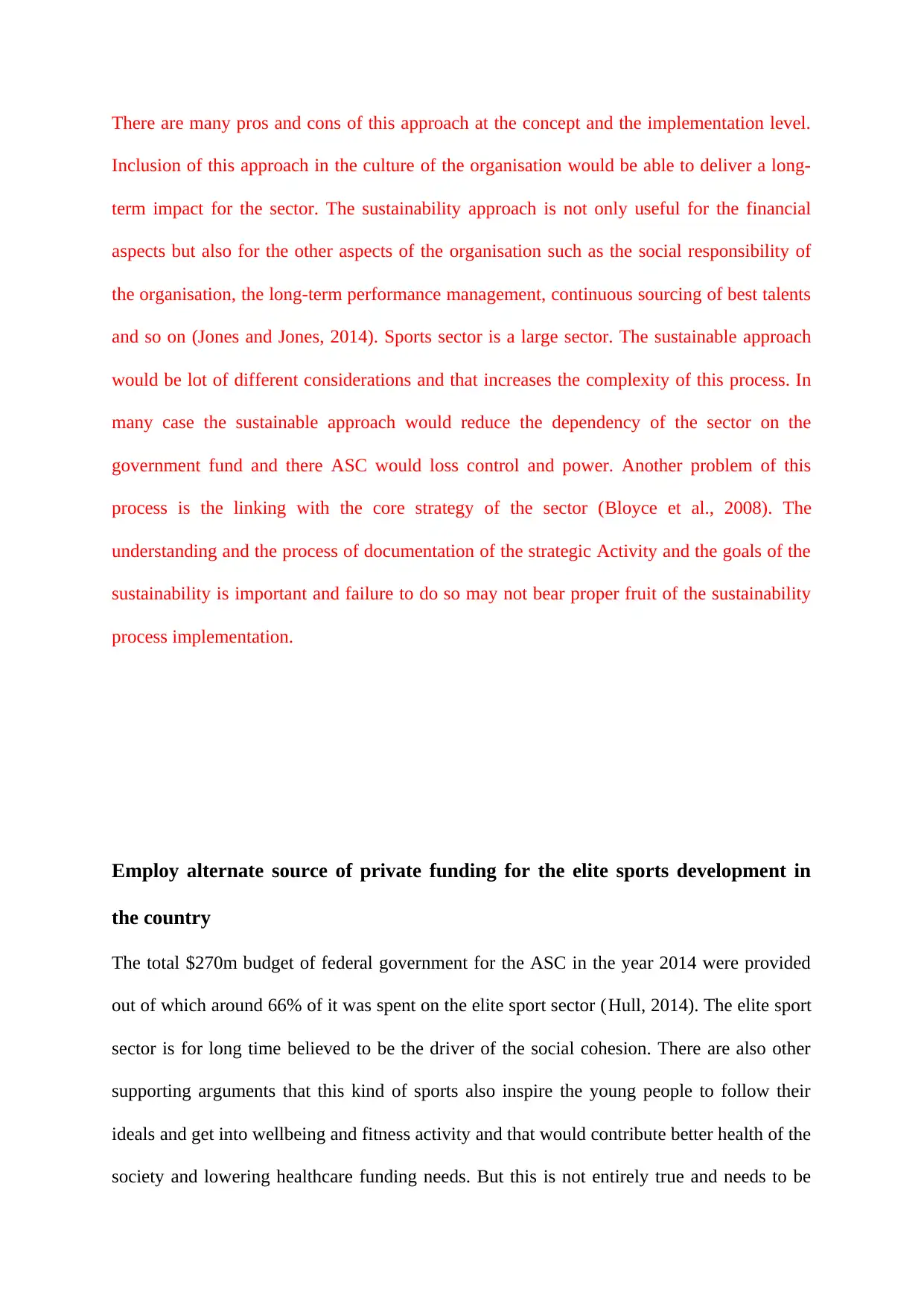
There are many pros and cons of this approach at the concept and the implementation level.
Inclusion of this approach in the culture of the organisation would be able to deliver a long-
term impact for the sector. The sustainability approach is not only useful for the financial
aspects but also for the other aspects of the organisation such as the social responsibility of
the organisation, the long-term performance management, continuous sourcing of best talents
and so on (Jones and Jones, 2014). Sports sector is a large sector. The sustainable approach
would be lot of different considerations and that increases the complexity of this process. In
many case the sustainable approach would reduce the dependency of the sector on the
government fund and there ASC would loss control and power. Another problem of this
process is the linking with the core strategy of the sector (Bloyce et al., 2008). The
understanding and the process of documentation of the strategic Activity and the goals of the
sustainability is important and failure to do so may not bear proper fruit of the sustainability
process implementation.
Employ alternate source of private funding for the elite sports development in
the country
The total $270m budget of federal government for the ASC in the year 2014 were provided
out of which around 66% of it was spent on the elite sport sector (Hull, 2014). The elite sport
sector is for long time believed to be the driver of the social cohesion. There are also other
supporting arguments that this kind of sports also inspire the young people to follow their
ideals and get into wellbeing and fitness activity and that would contribute better health of the
society and lowering healthcare funding needs. But this is not entirely true and needs to be
Inclusion of this approach in the culture of the organisation would be able to deliver a long-
term impact for the sector. The sustainability approach is not only useful for the financial
aspects but also for the other aspects of the organisation such as the social responsibility of
the organisation, the long-term performance management, continuous sourcing of best talents
and so on (Jones and Jones, 2014). Sports sector is a large sector. The sustainable approach
would be lot of different considerations and that increases the complexity of this process. In
many case the sustainable approach would reduce the dependency of the sector on the
government fund and there ASC would loss control and power. Another problem of this
process is the linking with the core strategy of the sector (Bloyce et al., 2008). The
understanding and the process of documentation of the strategic Activity and the goals of the
sustainability is important and failure to do so may not bear proper fruit of the sustainability
process implementation.
Employ alternate source of private funding for the elite sports development in
the country
The total $270m budget of federal government for the ASC in the year 2014 were provided
out of which around 66% of it was spent on the elite sport sector (Hull, 2014). The elite sport
sector is for long time believed to be the driver of the social cohesion. There are also other
supporting arguments that this kind of sports also inspire the young people to follow their
ideals and get into wellbeing and fitness activity and that would contribute better health of the
society and lowering healthcare funding needs. But this is not entirely true and needs to be
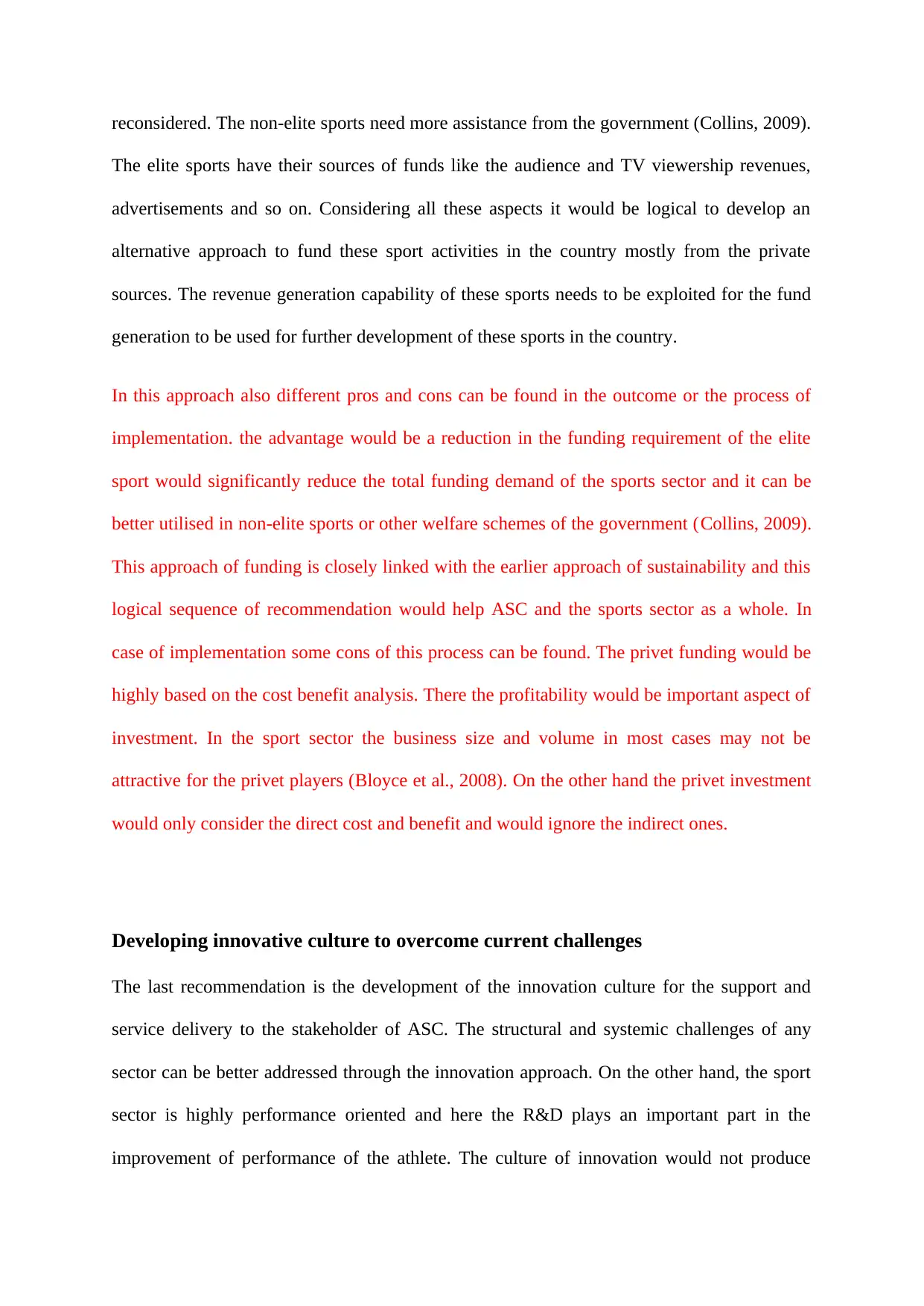
reconsidered. The non-elite sports need more assistance from the government (Collins, 2009).
The elite sports have their sources of funds like the audience and TV viewership revenues,
advertisements and so on. Considering all these aspects it would be logical to develop an
alternative approach to fund these sport activities in the country mostly from the private
sources. The revenue generation capability of these sports needs to be exploited for the fund
generation to be used for further development of these sports in the country.
In this approach also different pros and cons can be found in the outcome or the process of
implementation. the advantage would be a reduction in the funding requirement of the elite
sport would significantly reduce the total funding demand of the sports sector and it can be
better utilised in non-elite sports or other welfare schemes of the government (Collins, 2009).
This approach of funding is closely linked with the earlier approach of sustainability and this
logical sequence of recommendation would help ASC and the sports sector as a whole. In
case of implementation some cons of this process can be found. The privet funding would be
highly based on the cost benefit analysis. There the profitability would be important aspect of
investment. In the sport sector the business size and volume in most cases may not be
attractive for the privet players (Bloyce et al., 2008). On the other hand the privet investment
would only consider the direct cost and benefit and would ignore the indirect ones.
Developing innovative culture to overcome current challenges
The last recommendation is the development of the innovation culture for the support and
service delivery to the stakeholder of ASC. The structural and systemic challenges of any
sector can be better addressed through the innovation approach. On the other hand, the sport
sector is highly performance oriented and here the R&D plays an important part in the
improvement of performance of the athlete. The culture of innovation would not produce
The elite sports have their sources of funds like the audience and TV viewership revenues,
advertisements and so on. Considering all these aspects it would be logical to develop an
alternative approach to fund these sport activities in the country mostly from the private
sources. The revenue generation capability of these sports needs to be exploited for the fund
generation to be used for further development of these sports in the country.
In this approach also different pros and cons can be found in the outcome or the process of
implementation. the advantage would be a reduction in the funding requirement of the elite
sport would significantly reduce the total funding demand of the sports sector and it can be
better utilised in non-elite sports or other welfare schemes of the government (Collins, 2009).
This approach of funding is closely linked with the earlier approach of sustainability and this
logical sequence of recommendation would help ASC and the sports sector as a whole. In
case of implementation some cons of this process can be found. The privet funding would be
highly based on the cost benefit analysis. There the profitability would be important aspect of
investment. In the sport sector the business size and volume in most cases may not be
attractive for the privet players (Bloyce et al., 2008). On the other hand the privet investment
would only consider the direct cost and benefit and would ignore the indirect ones.
Developing innovative culture to overcome current challenges
The last recommendation is the development of the innovation culture for the support and
service delivery to the stakeholder of ASC. The structural and systemic challenges of any
sector can be better addressed through the innovation approach. On the other hand, the sport
sector is highly performance oriented and here the R&D plays an important part in the
improvement of performance of the athlete. The culture of innovation would not produce
Paraphrase This Document
Need a fresh take? Get an instant paraphrase of this document with our AI Paraphraser
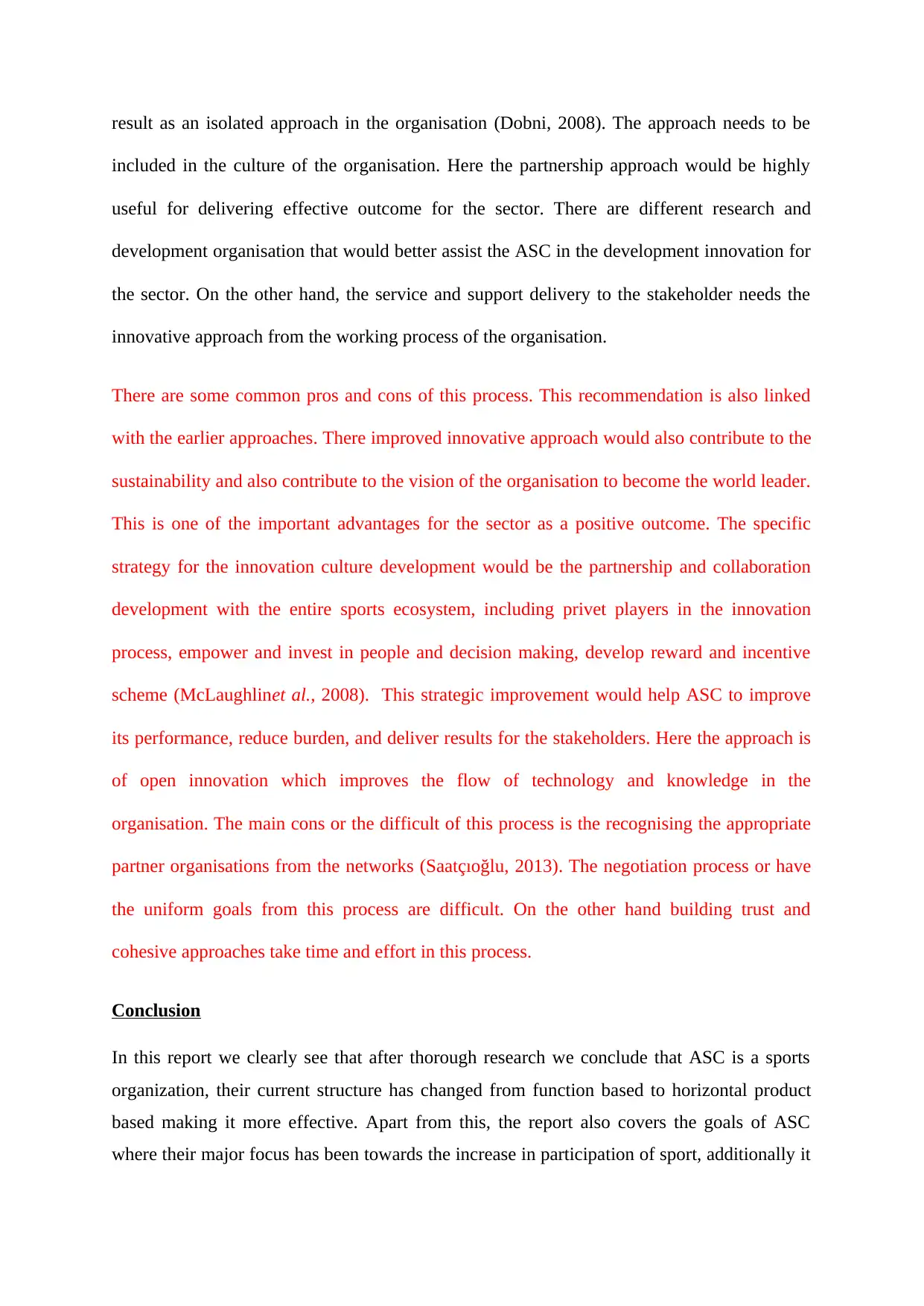
result as an isolated approach in the organisation (Dobni, 2008). The approach needs to be
included in the culture of the organisation. Here the partnership approach would be highly
useful for delivering effective outcome for the sector. There are different research and
development organisation that would better assist the ASC in the development innovation for
the sector. On the other hand, the service and support delivery to the stakeholder needs the
innovative approach from the working process of the organisation.
There are some common pros and cons of this process. This recommendation is also linked
with the earlier approaches. There improved innovative approach would also contribute to the
sustainability and also contribute to the vision of the organisation to become the world leader.
This is one of the important advantages for the sector as a positive outcome. The specific
strategy for the innovation culture development would be the partnership and collaboration
development with the entire sports ecosystem, including privet players in the innovation
process, empower and invest in people and decision making, develop reward and incentive
scheme (McLaughlinet al., 2008). This strategic improvement would help ASC to improve
its performance, reduce burden, and deliver results for the stakeholders. Here the approach is
of open innovation which improves the flow of technology and knowledge in the
organisation. The main cons or the difficult of this process is the recognising the appropriate
partner organisations from the networks (Saatçıoğlu, 2013). The negotiation process or have
the uniform goals from this process are difficult. On the other hand building trust and
cohesive approaches take time and effort in this process.
Conclusion
In this report we clearly see that after thorough research we conclude that ASC is a sports
organization, their current structure has changed from function based to horizontal product
based making it more effective. Apart from this, the report also covers the goals of ASC
where their major focus has been towards the increase in participation of sport, additionally it
included in the culture of the organisation. Here the partnership approach would be highly
useful for delivering effective outcome for the sector. There are different research and
development organisation that would better assist the ASC in the development innovation for
the sector. On the other hand, the service and support delivery to the stakeholder needs the
innovative approach from the working process of the organisation.
There are some common pros and cons of this process. This recommendation is also linked
with the earlier approaches. There improved innovative approach would also contribute to the
sustainability and also contribute to the vision of the organisation to become the world leader.
This is one of the important advantages for the sector as a positive outcome. The specific
strategy for the innovation culture development would be the partnership and collaboration
development with the entire sports ecosystem, including privet players in the innovation
process, empower and invest in people and decision making, develop reward and incentive
scheme (McLaughlinet al., 2008). This strategic improvement would help ASC to improve
its performance, reduce burden, and deliver results for the stakeholders. Here the approach is
of open innovation which improves the flow of technology and knowledge in the
organisation. The main cons or the difficult of this process is the recognising the appropriate
partner organisations from the networks (Saatçıoğlu, 2013). The negotiation process or have
the uniform goals from this process are difficult. On the other hand building trust and
cohesive approaches take time and effort in this process.
Conclusion
In this report we clearly see that after thorough research we conclude that ASC is a sports
organization, their current structure has changed from function based to horizontal product
based making it more effective. Apart from this, the report also covers the goals of ASC
where their major focus has been towards the increase in participation of sport, additionally it
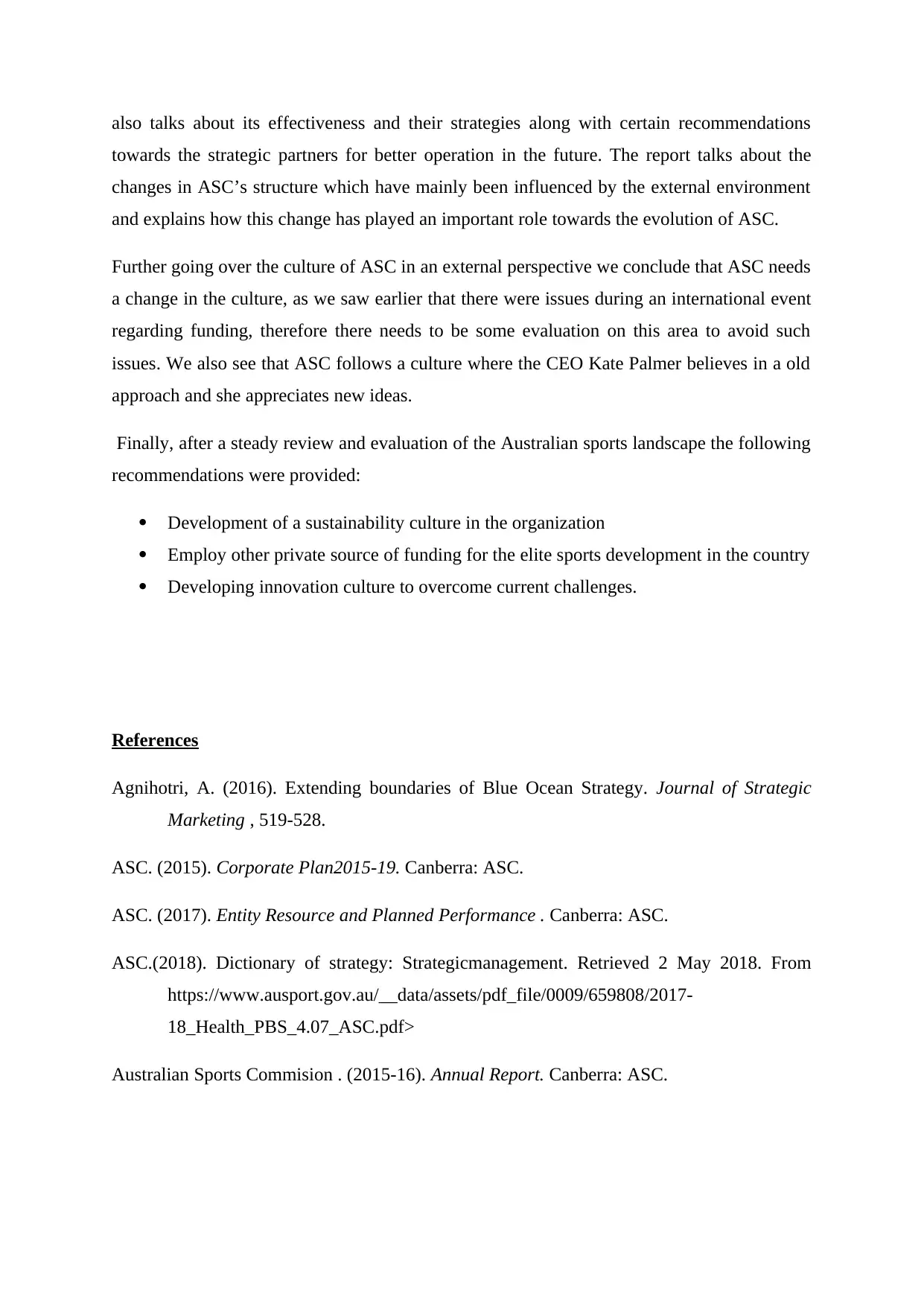
also talks about its effectiveness and their strategies along with certain recommendations
towards the strategic partners for better operation in the future. The report talks about the
changes in ASC’s structure which have mainly been influenced by the external environment
and explains how this change has played an important role towards the evolution of ASC.
Further going over the culture of ASC in an external perspective we conclude that ASC needs
a change in the culture, as we saw earlier that there were issues during an international event
regarding funding, therefore there needs to be some evaluation on this area to avoid such
issues. We also see that ASC follows a culture where the CEO Kate Palmer believes in a old
approach and she appreciates new ideas.
Finally, after a steady review and evaluation of the Australian sports landscape the following
recommendations were provided:
Development of a sustainability culture in the organization
Employ other private source of funding for the elite sports development in the country
Developing innovation culture to overcome current challenges.
References
Agnihotri, A. (2016). Extending boundaries of Blue Ocean Strategy. Journal of Strategic
Marketing , 519-528.
ASC. (2015). Corporate Plan2015-19. Canberra: ASC.
ASC. (2017). Entity Resource and Planned Performance . Canberra: ASC.
ASC.(2018). Dictionary of strategy: Strategicmanagement. Retrieved 2 May 2018. From
https://www.ausport.gov.au/__data/assets/pdf_file/0009/659808/2017-
18_Health_PBS_4.07_ASC.pdf>
Australian Sports Commision . (2015-16). Annual Report. Canberra: ASC.
towards the strategic partners for better operation in the future. The report talks about the
changes in ASC’s structure which have mainly been influenced by the external environment
and explains how this change has played an important role towards the evolution of ASC.
Further going over the culture of ASC in an external perspective we conclude that ASC needs
a change in the culture, as we saw earlier that there were issues during an international event
regarding funding, therefore there needs to be some evaluation on this area to avoid such
issues. We also see that ASC follows a culture where the CEO Kate Palmer believes in a old
approach and she appreciates new ideas.
Finally, after a steady review and evaluation of the Australian sports landscape the following
recommendations were provided:
Development of a sustainability culture in the organization
Employ other private source of funding for the elite sports development in the country
Developing innovation culture to overcome current challenges.
References
Agnihotri, A. (2016). Extending boundaries of Blue Ocean Strategy. Journal of Strategic
Marketing , 519-528.
ASC. (2015). Corporate Plan2015-19. Canberra: ASC.
ASC. (2017). Entity Resource and Planned Performance . Canberra: ASC.
ASC.(2018). Dictionary of strategy: Strategicmanagement. Retrieved 2 May 2018. From
https://www.ausport.gov.au/__data/assets/pdf_file/0009/659808/2017-
18_Health_PBS_4.07_ASC.pdf>
Australian Sports Commision . (2015-16). Annual Report. Canberra: ASC.
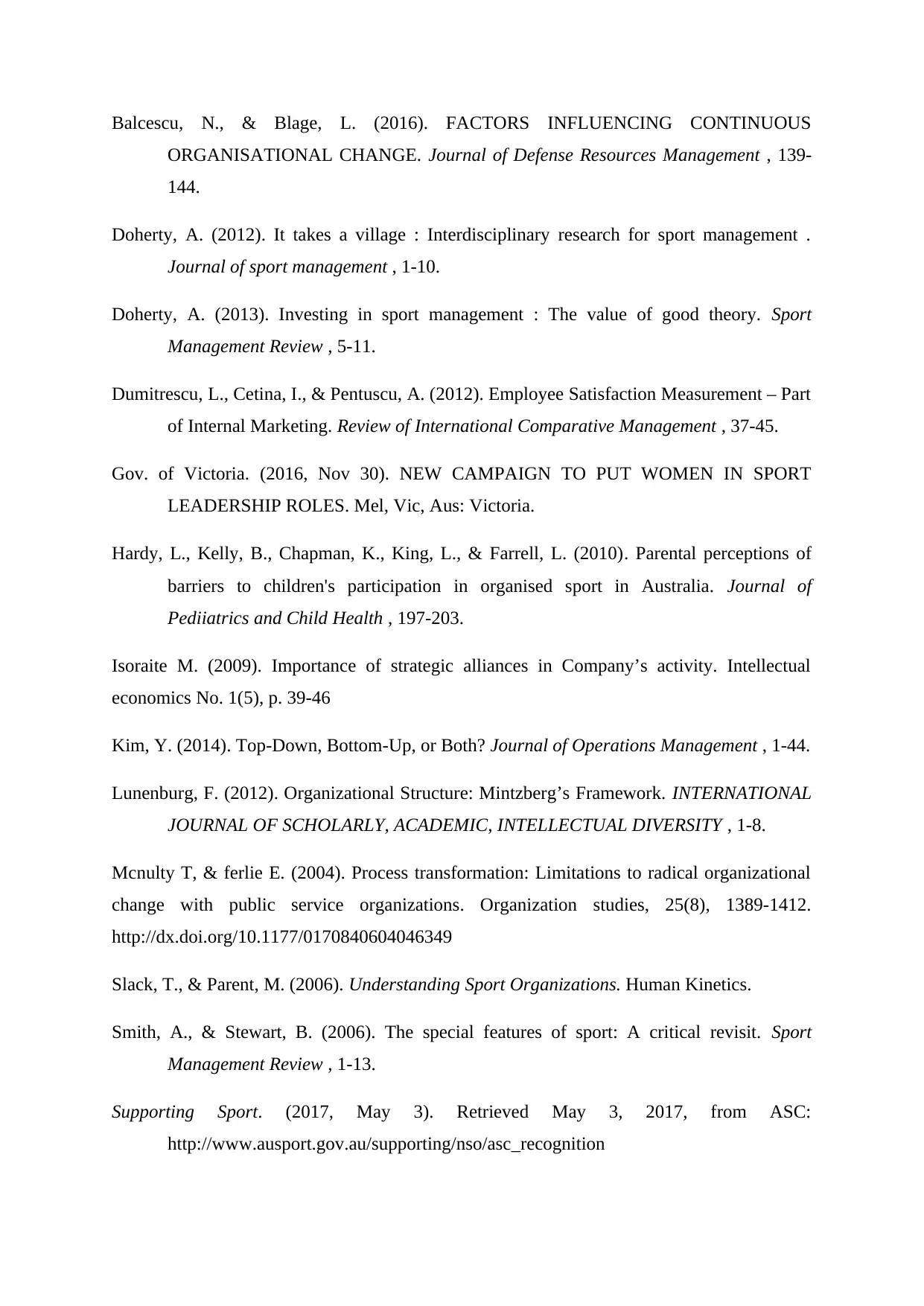
Balcescu, N., & Blage, L. (2016). FACTORS INFLUENCING CONTINUOUS
ORGANISATIONAL CHANGE. Journal of Defense Resources Management , 139-
144.
Doherty, A. (2012). It takes a village : Interdisciplinary research for sport management .
Journal of sport management , 1-10.
Doherty, A. (2013). Investing in sport management : The value of good theory. Sport
Management Review , 5-11.
Dumitrescu, L., Cetina, I., & Pentuscu, A. (2012). Employee Satisfaction Measurement – Part
of Internal Marketing. Review of International Comparative Management , 37-45.
Gov. of Victoria. (2016, Nov 30). NEW CAMPAIGN TO PUT WOMEN IN SPORT
LEADERSHIP ROLES. Mel, Vic, Aus: Victoria.
Hardy, L., Kelly, B., Chapman, K., King, L., & Farrell, L. (2010). Parental perceptions of
barriers to children's participation in organised sport in Australia. Journal of
Pediiatrics and Child Health , 197-203.
Isoraite M. (2009). Importance of strategic alliances in Company’s activity. Intellectual
economics No. 1(5), p. 39-46
Kim, Y. (2014). Top-Down, Bottom-Up, or Both? Journal of Operations Management , 1-44.
Lunenburg, F. (2012). Organizational Structure: Mintzberg’s Framework. INTERNATIONAL
JOURNAL OF SCHOLARLY, ACADEMIC, INTELLECTUAL DIVERSITY , 1-8.
Mcnulty T, & ferlie E. (2004). Process transformation: Limitations to radical organizational
change with public service organizations. Organization studies, 25(8), 1389-1412.
http://dx.doi.org/10.1177/0170840604046349
Slack, T., & Parent, M. (2006). Understanding Sport Organizations. Human Kinetics.
Smith, A., & Stewart, B. (2006). The special features of sport: A critical revisit. Sport
Management Review , 1-13.
Supporting Sport. (2017, May 3). Retrieved May 3, 2017, from ASC:
http://www.ausport.gov.au/supporting/nso/asc_recognition
ORGANISATIONAL CHANGE. Journal of Defense Resources Management , 139-
144.
Doherty, A. (2012). It takes a village : Interdisciplinary research for sport management .
Journal of sport management , 1-10.
Doherty, A. (2013). Investing in sport management : The value of good theory. Sport
Management Review , 5-11.
Dumitrescu, L., Cetina, I., & Pentuscu, A. (2012). Employee Satisfaction Measurement – Part
of Internal Marketing. Review of International Comparative Management , 37-45.
Gov. of Victoria. (2016, Nov 30). NEW CAMPAIGN TO PUT WOMEN IN SPORT
LEADERSHIP ROLES. Mel, Vic, Aus: Victoria.
Hardy, L., Kelly, B., Chapman, K., King, L., & Farrell, L. (2010). Parental perceptions of
barriers to children's participation in organised sport in Australia. Journal of
Pediiatrics and Child Health , 197-203.
Isoraite M. (2009). Importance of strategic alliances in Company’s activity. Intellectual
economics No. 1(5), p. 39-46
Kim, Y. (2014). Top-Down, Bottom-Up, or Both? Journal of Operations Management , 1-44.
Lunenburg, F. (2012). Organizational Structure: Mintzberg’s Framework. INTERNATIONAL
JOURNAL OF SCHOLARLY, ACADEMIC, INTELLECTUAL DIVERSITY , 1-8.
Mcnulty T, & ferlie E. (2004). Process transformation: Limitations to radical organizational
change with public service organizations. Organization studies, 25(8), 1389-1412.
http://dx.doi.org/10.1177/0170840604046349
Slack, T., & Parent, M. (2006). Understanding Sport Organizations. Human Kinetics.
Smith, A., & Stewart, B. (2006). The special features of sport: A critical revisit. Sport
Management Review , 1-13.
Supporting Sport. (2017, May 3). Retrieved May 3, 2017, from ASC:
http://www.ausport.gov.au/supporting/nso/asc_recognition
Secure Best Marks with AI Grader
Need help grading? Try our AI Grader for instant feedback on your assignments.
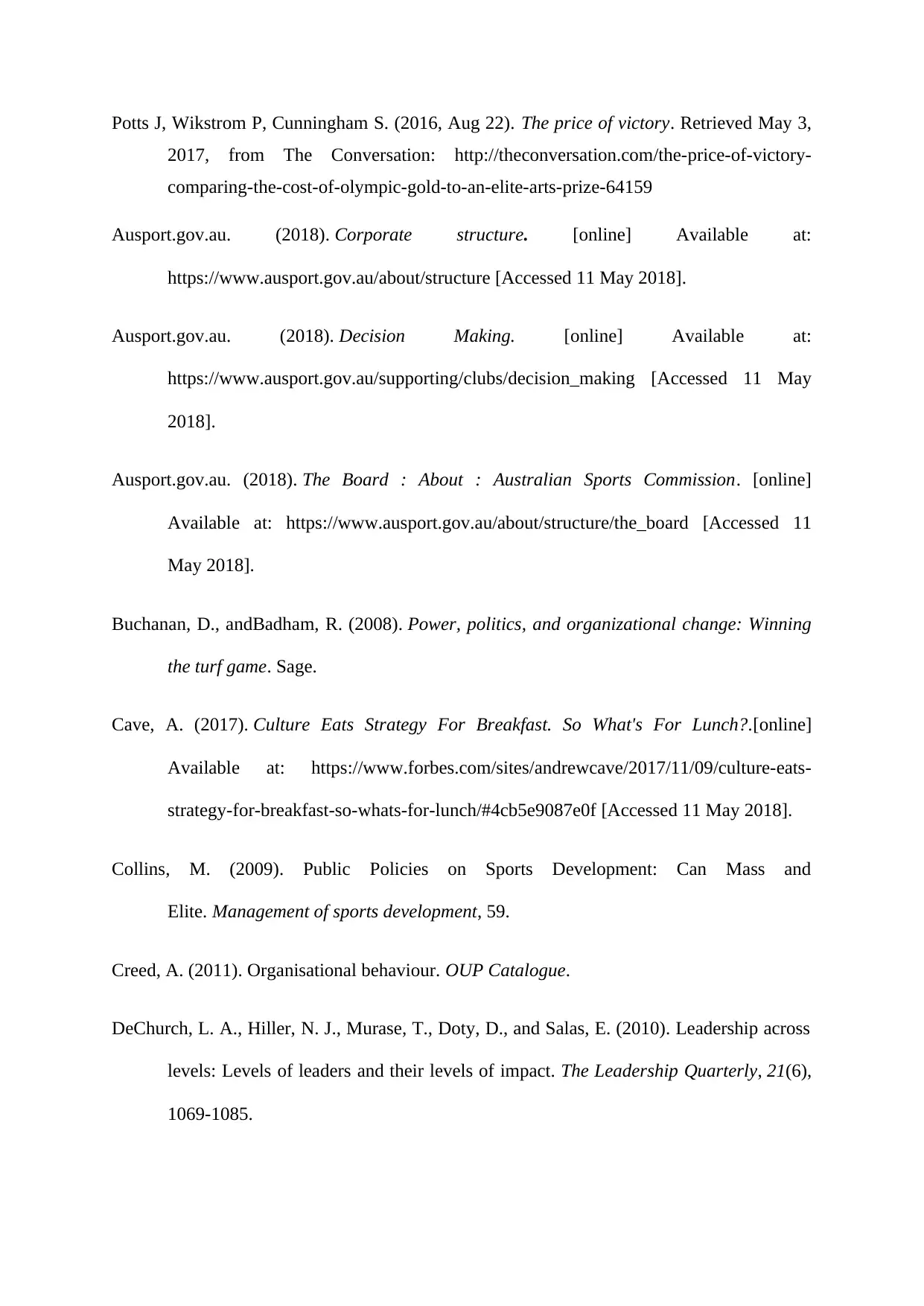
Potts J, Wikstrom P, Cunningham S. (2016, Aug 22). The price of victory. Retrieved May 3,
2017, from The Conversation: http://theconversation.com/the-price-of-victory-
comparing-the-cost-of-olympic-gold-to-an-elite-arts-prize-64159
Ausport.gov.au. (2018). Corporate structure. [online] Available at:
https://www.ausport.gov.au/about/structure [Accessed 11 May 2018].
Ausport.gov.au. (2018). Decision Making. [online] Available at:
https://www.ausport.gov.au/supporting/clubs/decision_making [Accessed 11 May
2018].
Ausport.gov.au. (2018). The Board : About : Australian Sports Commission. [online]
Available at: https://www.ausport.gov.au/about/structure/the_board [Accessed 11
May 2018].
Buchanan, D., andBadham, R. (2008). Power, politics, and organizational change: Winning
the turf game. Sage.
Cave, A. (2017). Culture Eats Strategy For Breakfast. So What's For Lunch?.[online]
Available at: https://www.forbes.com/sites/andrewcave/2017/11/09/culture-eats-
strategy-for-breakfast-so-whats-for-lunch/#4cb5e9087e0f [Accessed 11 May 2018].
Collins, M. (2009). Public Policies on Sports Development: Can Mass and
Elite. Management of sports development, 59.
Creed, A. (2011). Organisational behaviour. OUP Catalogue.
DeChurch, L. A., Hiller, N. J., Murase, T., Doty, D., and Salas, E. (2010). Leadership across
levels: Levels of leaders and their levels of impact. The Leadership Quarterly, 21(6),
1069-1085.
2017, from The Conversation: http://theconversation.com/the-price-of-victory-
comparing-the-cost-of-olympic-gold-to-an-elite-arts-prize-64159
Ausport.gov.au. (2018). Corporate structure. [online] Available at:
https://www.ausport.gov.au/about/structure [Accessed 11 May 2018].
Ausport.gov.au. (2018). Decision Making. [online] Available at:
https://www.ausport.gov.au/supporting/clubs/decision_making [Accessed 11 May
2018].
Ausport.gov.au. (2018). The Board : About : Australian Sports Commission. [online]
Available at: https://www.ausport.gov.au/about/structure/the_board [Accessed 11
May 2018].
Buchanan, D., andBadham, R. (2008). Power, politics, and organizational change: Winning
the turf game. Sage.
Cave, A. (2017). Culture Eats Strategy For Breakfast. So What's For Lunch?.[online]
Available at: https://www.forbes.com/sites/andrewcave/2017/11/09/culture-eats-
strategy-for-breakfast-so-whats-for-lunch/#4cb5e9087e0f [Accessed 11 May 2018].
Collins, M. (2009). Public Policies on Sports Development: Can Mass and
Elite. Management of sports development, 59.
Creed, A. (2011). Organisational behaviour. OUP Catalogue.
DeChurch, L. A., Hiller, N. J., Murase, T., Doty, D., and Salas, E. (2010). Leadership across
levels: Levels of leaders and their levels of impact. The Leadership Quarterly, 21(6),
1069-1085.
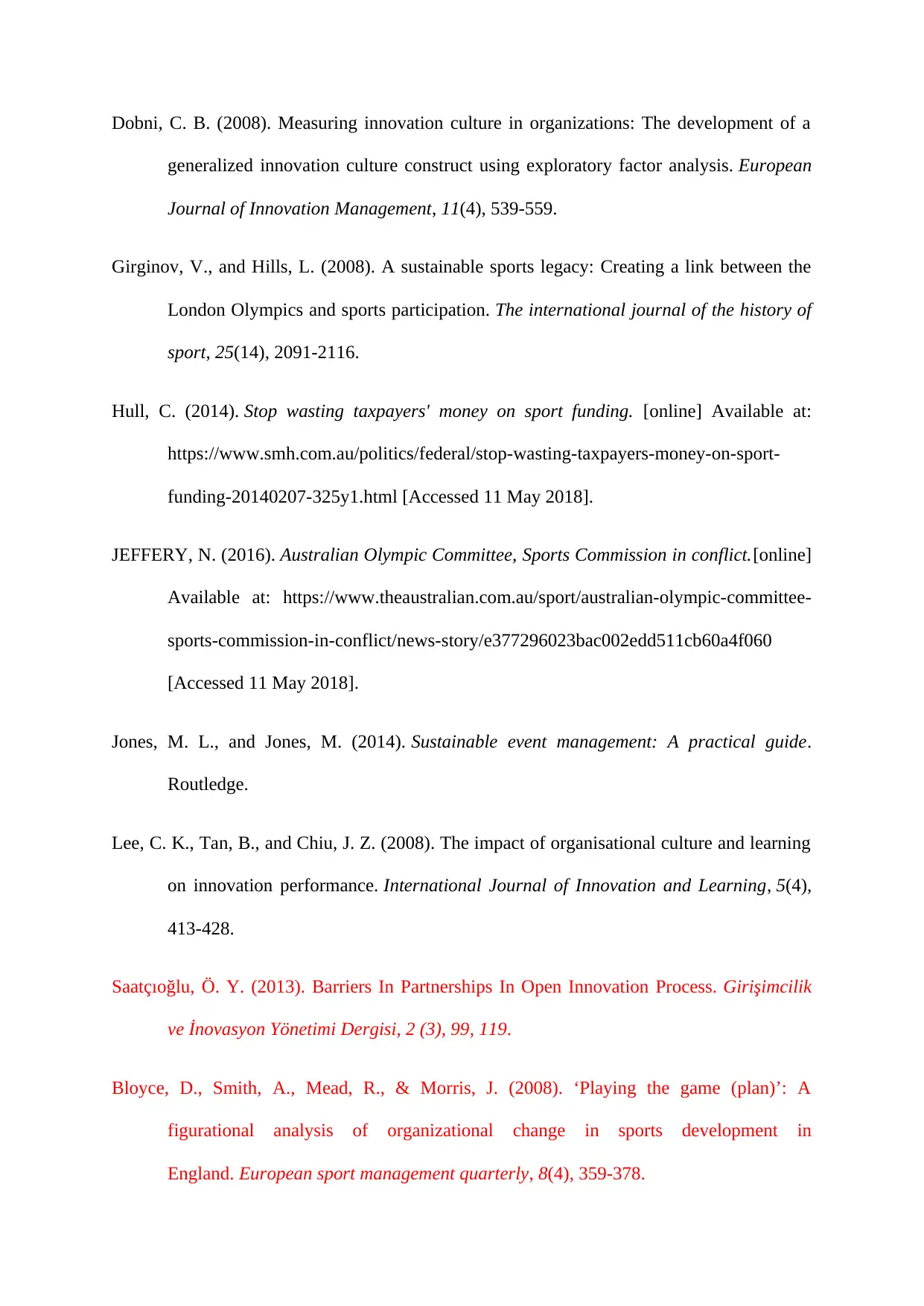
Dobni, C. B. (2008). Measuring innovation culture in organizations: The development of a
generalized innovation culture construct using exploratory factor analysis. European
Journal of Innovation Management, 11(4), 539-559.
Girginov, V., and Hills, L. (2008). A sustainable sports legacy: Creating a link between the
London Olympics and sports participation. The international journal of the history of
sport, 25(14), 2091-2116.
Hull, C. (2014). Stop wasting taxpayers' money on sport funding. [online] Available at:
https://www.smh.com.au/politics/federal/stop-wasting-taxpayers-money-on-sport-
funding-20140207-325y1.html [Accessed 11 May 2018].
JEFFERY, N. (2016). Australian Olympic Committee, Sports Commission in conflict.[online]
Available at: https://www.theaustralian.com.au/sport/australian-olympic-committee-
sports-commission-in-conflict/news-story/e377296023bac002edd511cb60a4f060
[Accessed 11 May 2018].
Jones, M. L., and Jones, M. (2014). Sustainable event management: A practical guide.
Routledge.
Lee, C. K., Tan, B., and Chiu, J. Z. (2008). The impact of organisational culture and learning
on innovation performance. International Journal of Innovation and Learning, 5(4),
413-428.
Saatçıoğlu, Ö. Y. (2013). Barriers In Partnerships In Open Innovation Process. Girişimcilik
ve İnovasyon Yönetimi Dergisi, 2 (3), 99, 119.
Bloyce, D., Smith, A., Mead, R., & Morris, J. (2008). ‘Playing the game (plan)’: A
figurational analysis of organizational change in sports development in
England. European sport management quarterly, 8(4), 359-378.
generalized innovation culture construct using exploratory factor analysis. European
Journal of Innovation Management, 11(4), 539-559.
Girginov, V., and Hills, L. (2008). A sustainable sports legacy: Creating a link between the
London Olympics and sports participation. The international journal of the history of
sport, 25(14), 2091-2116.
Hull, C. (2014). Stop wasting taxpayers' money on sport funding. [online] Available at:
https://www.smh.com.au/politics/federal/stop-wasting-taxpayers-money-on-sport-
funding-20140207-325y1.html [Accessed 11 May 2018].
JEFFERY, N. (2016). Australian Olympic Committee, Sports Commission in conflict.[online]
Available at: https://www.theaustralian.com.au/sport/australian-olympic-committee-
sports-commission-in-conflict/news-story/e377296023bac002edd511cb60a4f060
[Accessed 11 May 2018].
Jones, M. L., and Jones, M. (2014). Sustainable event management: A practical guide.
Routledge.
Lee, C. K., Tan, B., and Chiu, J. Z. (2008). The impact of organisational culture and learning
on innovation performance. International Journal of Innovation and Learning, 5(4),
413-428.
Saatçıoğlu, Ö. Y. (2013). Barriers In Partnerships In Open Innovation Process. Girişimcilik
ve İnovasyon Yönetimi Dergisi, 2 (3), 99, 119.
Bloyce, D., Smith, A., Mead, R., & Morris, J. (2008). ‘Playing the game (plan)’: A
figurational analysis of organizational change in sports development in
England. European sport management quarterly, 8(4), 359-378.
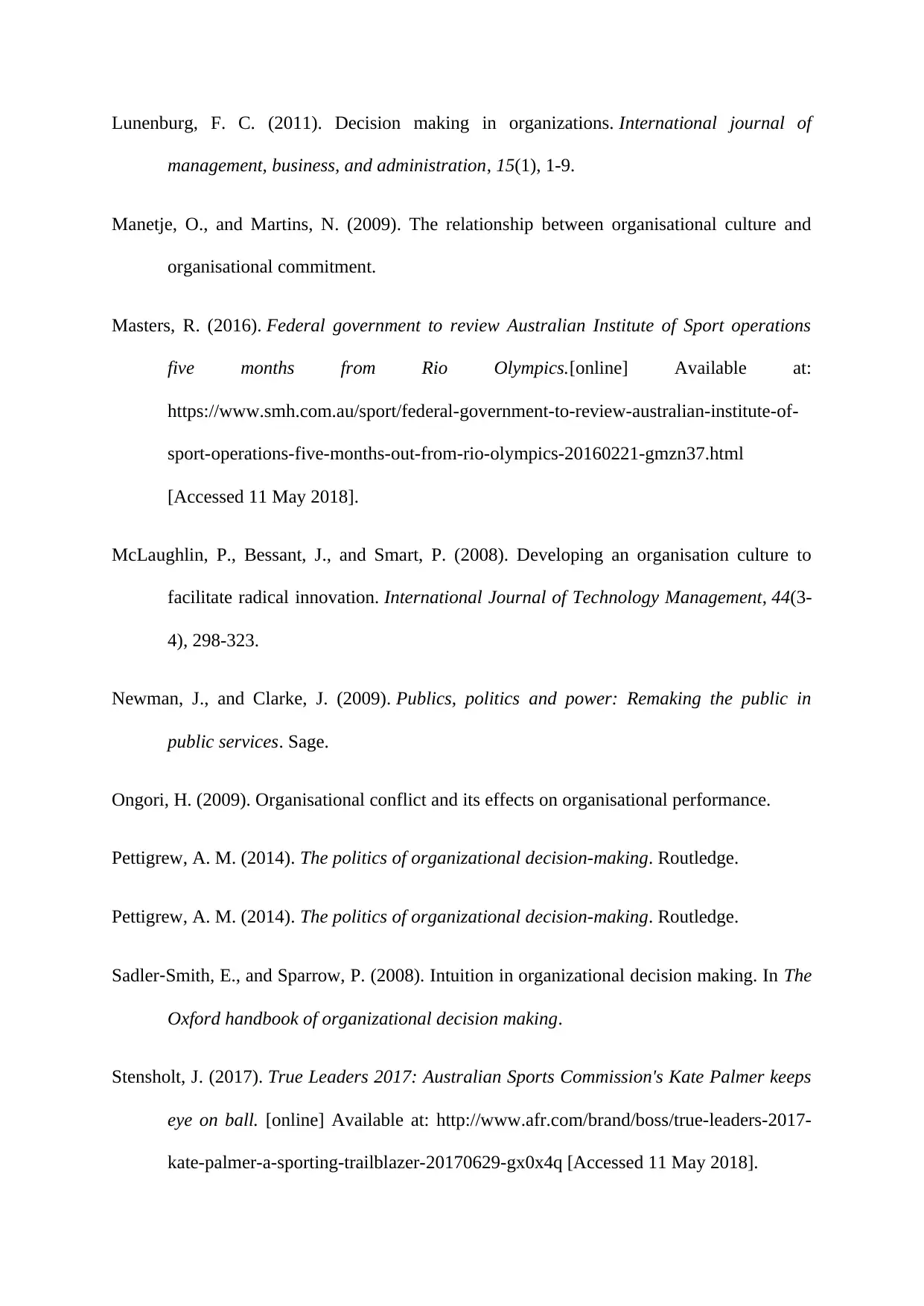
Lunenburg, F. C. (2011). Decision making in organizations. International journal of
management, business, and administration, 15(1), 1-9.
Manetje, O., and Martins, N. (2009). The relationship between organisational culture and
organisational commitment.
Masters, R. (2016). Federal government to review Australian Institute of Sport operations
five months from Rio Olympics.[online] Available at:
https://www.smh.com.au/sport/federal-government-to-review-australian-institute-of-
sport-operations-five-months-out-from-rio-olympics-20160221-gmzn37.html
[Accessed 11 May 2018].
McLaughlin, P., Bessant, J., and Smart, P. (2008). Developing an organisation culture to
facilitate radical innovation. International Journal of Technology Management, 44(3-
4), 298-323.
Newman, J., and Clarke, J. (2009). Publics, politics and power: Remaking the public in
public services. Sage.
Ongori, H. (2009). Organisational conflict and its effects on organisational performance.
Pettigrew, A. M. (2014). The politics of organizational decision-making. Routledge.
Pettigrew, A. M. (2014). The politics of organizational decision-making. Routledge.
Sadler‐Smith, E., and Sparrow, P. (2008). Intuition in organizational decision making. In The
Oxford handbook of organizational decision making.
Stensholt, J. (2017). True Leaders 2017: Australian Sports Commission's Kate Palmer keeps
eye on ball. [online] Available at: http://www.afr.com/brand/boss/true-leaders-2017-
kate-palmer-a-sporting-trailblazer-20170629-gx0x4q [Accessed 11 May 2018].
management, business, and administration, 15(1), 1-9.
Manetje, O., and Martins, N. (2009). The relationship between organisational culture and
organisational commitment.
Masters, R. (2016). Federal government to review Australian Institute of Sport operations
five months from Rio Olympics.[online] Available at:
https://www.smh.com.au/sport/federal-government-to-review-australian-institute-of-
sport-operations-five-months-out-from-rio-olympics-20160221-gmzn37.html
[Accessed 11 May 2018].
McLaughlin, P., Bessant, J., and Smart, P. (2008). Developing an organisation culture to
facilitate radical innovation. International Journal of Technology Management, 44(3-
4), 298-323.
Newman, J., and Clarke, J. (2009). Publics, politics and power: Remaking the public in
public services. Sage.
Ongori, H. (2009). Organisational conflict and its effects on organisational performance.
Pettigrew, A. M. (2014). The politics of organizational decision-making. Routledge.
Pettigrew, A. M. (2014). The politics of organizational decision-making. Routledge.
Sadler‐Smith, E., and Sparrow, P. (2008). Intuition in organizational decision making. In The
Oxford handbook of organizational decision making.
Stensholt, J. (2017). True Leaders 2017: Australian Sports Commission's Kate Palmer keeps
eye on ball. [online] Available at: http://www.afr.com/brand/boss/true-leaders-2017-
kate-palmer-a-sporting-trailblazer-20170629-gx0x4q [Accessed 11 May 2018].
Paraphrase This Document
Need a fresh take? Get an instant paraphrase of this document with our AI Paraphraser

1 out of 32
Related Documents
Your All-in-One AI-Powered Toolkit for Academic Success.
+13062052269
info@desklib.com
Available 24*7 on WhatsApp / Email
![[object Object]](/_next/static/media/star-bottom.7253800d.svg)
Unlock your academic potential
© 2024 | Zucol Services PVT LTD | All rights reserved.





